Physical Address
304 North Cardinal St.
Dorchester Center, MA 02124
Renal biopsy is an important tool used in the evaluation of patients with renal disease. Utilizing this procedure, it is possible to establish an accurate diagnosis, obtain critical information on the evolution and prognosis of the disease process, and develop a rational approach to the treatment of a renal disorder. Even in advanced stages of kidney damage, a biopsy can provide clues regarding the possibility of recurrence of the disease following transplantation. The renal biopsy is also important in the management of the transplant recipient, representing the most accurate method for determining the presence of antibody- or T cell–mediated rejection, acute tubular injury, calcineurin inhibitor nephrotoxicity, or the development of de novo or recurrent glomerulonephritis in the allograft.
Renal disease is usually manifested by a limited number of symptoms that are commonly grouped in clinical syndromes, that is, nephrotic syndrome, persistent proteinuria, acute nephritic syndrome, persistent or recurrent hematuria, asymptomatic renal insufficiency, hypertension, rapidly progressive renal failure, acute renal failure, and chronic renal failure. Given the fact that the kidney reacts to a variety of injurious agents with a limited number of histopathologic patterns of injury, a given clinical syndrome can be associated with several histopathologic patterns, while a single histopathologic pattern may be linked to more than one syndrome. The accurate interpretation of a renal biopsy requires detailed knowledge of the structure and function of the normal kidney, as well as an understanding of the clinical, morphologic, and histopathogenic aspects of renal disease. To evaluate a kidney biopsy, the pathologist should correlate the clinical and laboratory information with light microscopic, immunofluorescence, and ultrastructural findings.
Most renal biopsies are done by either the percutaneous route using a cutting needle or by direct exposure of the kidney (open biopsy, often a wedge sampling of outer cortex). Most centers use 16–18-gauge needles for adults and 18-gauge needles for children less than 8 years of age. The specimen should be divided for light microscopy, immunofluorescence, and electron microscopy. Ideally, two biopsy cores should be obtained when a needle biopsy is performed. From the first core, two or more samples measuring 0.5–1 mm in thickness are taken from each end with a fresh razor or scalpel blade and placed in a cold solution of 2% glutaraldehyde in phosphate or cacodylate buffer for electron microscopy studies while the remaining tissue is placed in saline. If the second core is adequate, samples should also be taken from each end for electron microscopy, while the remainder is snap frozen in liquid nitrogen or in isopentane cooled on dry ice for immunofluorescence. For light microscopy, the tissue that was placed in saline should be transferred to a fixative, most common being 10% buffered formalin. If only one core is obtained, material should be taken from each end for electron microscopy and the remainder divided for light microscopy and immunofluorescence. If the core is too small, the specimen should be divided for electron microscopy and immunofluorescence studies since most of the light microscopic information can be obtained from the study of semi-thin sections of the plastic-embedded tissue processed for electron microscopy. Longitudinal division of the cores should be avoided. The triaging of the biopsy sample should ideally ensure that all three portions include cortex. On gross examination of the cores under dissecting microscope or loupe (magnifying device), glomeruli in well-preserved cortex appear as pale or congested bulges; however, this may not be evident when cores with sclerotic glomeruli or fibrotic interstium are examined.
A variety of fixatives have been recommended for the light microscopic study of renal biopsies. Zenker, Helly, Bouin, and Van der Griff fixatives are sometimes used and many pathologists feel that mercuric solutions provide the best architectural and cytologic detail. However, 10% neutral formalin can also provide good morphologic detail while also preserving the sample for future immunohistochemical studies or immunofluorescence microscopy on paraffin-embedded tissues, if needed. To evaluate for glycogen or crystals of urate, uric acid, and other water-soluble substances, tissue should be fixed in ethanol. A panel of hematoxylin and eosin (H&E), periodic acid–Schiff (PAS), methenamine silver, and trichrome stains are recommended for the routine evaluation of renal biopsies, but from the practical point of view, PAS is the most useful, is easiest to perform, and can also provide most of the information obtained from other stains. It is recommended that the biopsy core be serially sectioned (2–3 µm thick) and that three to four tissue sections be placed on each slide. At regular intervals, one slide is stained with H&E, one with PAS, one with trichrome, and another with silver stain. By following this procedure, the maximum number of glomeruli can be examined. The remaining unstained slides are saved in case special stains or immunohistochemical stains are needed.
There is a general misconception that electron microscopy is a complex and time-consuming procedure. In fact, satisfactory processing methods have been developed that require less than 5 hours. Many fixatives have been developed for this procedure, each of which has specific advantages. Some pathologists prefer a primary fixation in osmium tetroxide for the optimal demonstration of deposits and basement membrane structure, but glutaraldehyde fixation with post-osmification is more convenient and is suitable as a routine procedure. For tissue embedding, various epoxy resins with comparable characteristics are available and their selection is a matter of personal preference. Semi-thin (1 µm thick) sections obtained from the plastic-embedded tissue blocks are stained with toluidine blue or methylene blue and carefully studied as they can yield a great deal of information, especially when examined at high magnification ( Fig. 23.1 ). Thin sections from the blocks selected for ultrastructural study are double-stained with uranyl acetate and lead citrate for electron microscopic examination.

Direct immunofluorescence performed on frozen sections is the simpler, faster, and most satisfactory method for the routine evaluation of a renal biopsy, but indirect methods may be used for extra sensitivity or for a specific antibody. The portion of the biopsy specimen selected for immunofluorescence is oriented in standard frozen section embedding compound on a piece of cork and is snap frozen by immersion in a beaker containing either isopentane or methylbutane surrounded by liquid nitrogen or dry ice. Frozen sections of 2–4 µm thick are cut and stained with specific antibodies and examined under ultraviolet light using either transmitted or incident illumination, and the reactions are graded subjectively using a scale of 0 to 3+ (or 4+, depending on individual labs) and recorded by photography. The antibodies that are most commonly used are those against immunoglobulin (Ig)G, IgA, IgM, kappa and lambda light chains, C1q, C3, C4, and fibrinogen or fibrin. Immunostaining for a variety of other antigens can also be performed for selective diagnostic purposes. For example, C4d is very useful for the diagnosis of antibody-mediated acute allograft rejection. IgG subclass identification (IgG1, IgG2, IgG3, IgG4) and phospholipase A2 receptor 1 (PLA 2 R) staining is helpful in the diagnosis of primary membranous nephropathy.
In those cases in which glomeruli are not present in the portion of the submitted biopsy specimen, immunofluorescence studies can be successfully performed on pronase predigested tissue sections prepared from the portion of the biopsy allocated for light microscopy. It should be mentioned, however, that immunofluorescence for detecting C3 on these specimens is less sensitive when compared with that performed on frozen tissue sections. In addition, anti-glomerular basement membrane (GBM) disease cannot be diagnosed by this pronase method due to high background staining.
Immunohistochemical studies can also be performed on formalin-fixed, paraffin-embedded biopsy specimens. In addition to extensive panel needed in the evaluation of incidental solid tumors or hematolymphoid neoplasms, the commonly used immunohistochemical stains in the context of medical renal biopsies include BK (or SV40) stain in the diagnosis of BK polyomavirus nephropathy, adenovirus stain, cytomegalovirus stain, and C4d and amyloid A stain. Epstein–Barr virus (EBV) in situ hybridization is helpful in suspected cases of post-transplant lymphoproliferative disorders.
Although potentially challenging, the diagnosis of renal biopsy specimens is based on the same foundation of careful observation and clinicopathologic correlation that is used in other areas of pathology. A knowledge of normal morphology is essential for the recognition of any alteration that may occur in the various components of the kidney. Obtaining adequate clinical history is crucial to any renal biopsy interpretation. A checklist that can be used during the biopsy evaluation is provided in Table 23.1 .
| LIGHT MICROSCOPY | IMMUNOFLUORESCENCE | ELECTRON MICROSCOPY | |
|---|---|---|---|
| Glomeruli | Size and cellularity | Positive/negative reaction | Basement membrane (thickness, density, contours, disruptions) |
| Segmental or global changes | Reagent Igs, complement, fibrin, etc. | Cellular changes | |
| Mesangium | Distribution (mesangium, capillary wall, intracapillary globules) | Mesangium | |
| Leukocytes | Pattern (linear or granular or smudgy) | Deposits (type, location, and substructure) | |
| Capillary walls/lumens | Intensity | Inclusions in endothelial cells | |
| Necrosis | Necrosis, cellular crescents or intracapillary thrombi on fibrin stain | ||
| Thrombi (type) | |||
| Adhesions to Bowman capsule | |||
| Deposits (type and location) | |||
| Crescents (type and %) | |||
| Sclerosis (distribution and %) | |||
| Tubules | Necrosis | Reactions and pattern | Cellular changes |
| Reparative changes | Intensity | Inclusions | |
| Dilation | Basement membrane | ||
| Casts (type) | Deposits (type and location) | ||
| Crystals | |||
| Cellular inclusions | |||
| Vacuolization | |||
| Basement membrane | |||
| Blood vessels | Intimal thickening (type) | Reactions and distribution | Intimal and medial changes |
| Elastica changes | Thrombi or vasculitis on fibrin stain | Deposits | |
| Media hypertrophy | |||
| Hyalinosis | |||
| Thrombi | |||
| Necrosis | |||
| Inflammation | |||
| Juxtaglomerular apparatus | |||
| Interstitium | Edema | Reactions and distribution | Cellular infiltrates |
| Inflammation and fibrosis (cell type and %) | Deposits |
A renal biopsy must contain glomeruli to be considered adequate, but there is disagreement over the number of glomeruli required to make a diagnosis. The definition of adequacy largely depends on the disease under consideration. In disorders characterized by irregular or crescentic proliferation, the assessment should be based on a minimum of 10 glomeruli, whereas, in diffuse lesions (such as membranous glomerulonephritis [MGN]), the identification of specific features in a single glomerulus may be sufficient, especially if ultrastructural studies are also performed. While there is often a variation in the severity of a specific lesion among different glomeruli, even in diffuse processes, a good guideline to follow is that at least 5–10 glomeruli should be examined to properly assess the extent of the disease.
Since most of the changes seen in renal biopsies occur in the glomerulus, we will briefly review the morphology of this structure. The glomerulus is a vascular structure composed of a tuft of specialized capillaries that arise from the afferent arteriole to form lobules, then rejoin the vascular pole to drain into the efferent arteriole. Normally, the lobules are poorly defined, but they are highlighted in some disease processes. Each lobule consists of a cluster of capillaries supported by the mesangium, which forms the centrolobular or axial framework of the glomerular tuft. The tuft of capillaries lies within the lumen of the expanded proximal end of the nephron, or Bowman space, which is lined on its parietal aspect by a layer of attenuated epithelial cells overlying a thick basement membrane. Together, the latter two structures make up the Bowman capsule , which is continuous at the vascular pole of the glomerulus with the adventitia of the afferent and efferent arterioles. At the urinary pole, the basement membrane of the Bowman capsule merges with that of the proximal tubule. Each glomerulus measures approximately 200 µm in diameter, but they are all not of the same size. Those located in the juxtamedullary area are about 20% larger than those elsewhere in the cortex. The cellularity of the glomerulus varies in different diseases, and an accurate assessment requires histologic preparations of 2–4 µm thickness. The presence of more than three cells in an individual glomerular mesangial region away from the vascular pole is considered hypercellularity.
The walls of the glomerular capillaries are clothed by a reflected layer of cells of the Bowman capsule. These highly specialized epithelial cells are known as podocytes (visceral epithelial cells) because they have numerous tiny foot processes that rest on the basement membrane that separates them from the attenuated, fenestrated endothelium of the capillaries. The GBM is a trilaminar structure composed of a central electron-dense zone, or lamina densa, bordered by two narrow electron-lucent layers: the lamina rara interna and the lamina rara externa. The major components of the GBM are type IV collagen, laminin, heparan sulfate proteoglycans, and entactin, but minor amounts of other proteins have also been found.
The principal function of the glomerulus is filtration, and the GBM is the main component of the filtration barrier. In normal adults, the GBM measures 310–380 nm in thickness; it is somewhat thinner in children (and achieving adult thickness by 10–12 years age), and slightly thicker in males than in females. The GBM does not completely surround the capillary lumen since the vessel is attached to the mesangium, which consists of mesangial cells embedded in a basement membrane–like material, the mesangial matrix ( Fig. 23.2 ). By electron microscopy, the mesangial matrix appears more fibrillar than the GBM. It is composed of collagen types IV, V, and VI, fibronectin, laminin, entactin, and sulfated glycosaminoglycans, including heparan sulfate and chondroitin sulfate. The mesangial cells have cytoplasmic processes that contain α-smooth muscle actin, α-actinin, and myosin filaments, characteristics shared by smooth muscle cells, pericytes, and myofibroblasts. Mesangial cells thus possess contractile properties and are probably involved in the regulation of blood flow through the glomeruli and modulation of the filtration process. They produce growth factors that allow normal cell turnover. Mesangial cells may also have some phagocytic activity and play a role in the clearance of debris, including immune deposits from the mesangium. Although obvious ultrastructural differences exist between the endothelial and mesangial cells, these differences are not always evident in glomerular diseases, and the distinction between the endothelium and the mesangium is usually based on the location of these structures in the glomerulus.
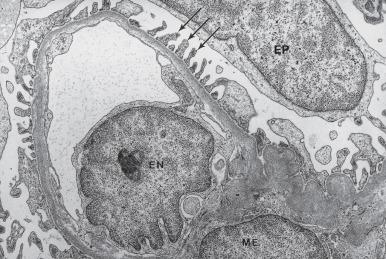
The visceral epithelial cells/podocytes are involved in basement membrane synthesis and, by their unique structure, play an important role in glomerular permeability. These cells cover the GBM on its urinary side and are attached to it by cytoplasmic extensions or foot processes that, under the scanning electron microscope, appear as a complex of interdigitating structures originating from different epithelial cells ( Fig. 23.3 ). The foot processes are approximately 25–60 nm apart, with a connecting slit-pore diaphragm 4–7 nm thick that shows similarities with tight and adherens junctions. Several molecules identified in podocyte foot processes and slit diaphragms over the last two decades contribute to the structural integrity and permselectivity of the filtration barrier. Bowman capsule limits the urinary space and is lined by a layer of flattened parietal epithelial cells that express cytokeratin proteins. In contrast, the visceral epithelial cells do not immunoreact for cytokeratin but do for vimentin and desmin. Recent evidence suggests that parietal epithelial stem cells are critical in glomerular repair and maybe involved in the regeneration of podocytes and tubular epithelial cells.
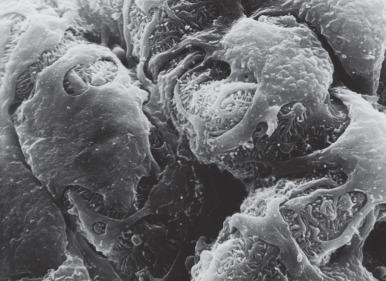
Glomerulonephritis is a term denoting an inflammation of the glomerulus, while glomerulopathy is an all-embracing term for disorders affecting this structure. In glomerular diseases, other parts of the nephron may also be involved, but the diagnosis hinges on the identification of a derangement of the normal glomerular configuration. While the changes may be recognizable by routine light microscopy, the findings from immunofluorescence are often significant. Electron microscopy is always informative and is sometimes the only means whereby the structural changes can be detected and defined. The damage to the glomeruli may take the form of definable morphologic patterns, and subdivisions in the character or distribution of the glomerular lesions are used to classify glomerulonephritis. Although there is general agreement on the definitions applied to the distribution of glomerular lesions ( Box 23.1 ), more specific categorizations are sometimes controversial.
Classification of disease distribution when many glomeruli are considered
Focal: disease affecting only some of the glomeruli
Diffuse: disease affecting most or all glomeruli
Classification of disease distribution when single glomeruli are considered
Segmental: a lesion involving only a part of the glomerulus
Global: a lesion involving the entire glomerulus
In this chapter, glomerular lesions are subdivided into those associated with the nephrotic syndrome or persistent proteinuria, those seen in acute nephritis or hematuria, and lesions associated with vascular diseases, such as systemic vasculitis, hemolytic uremic syndrome (HUS), and systemic sclerosis. Separate sections, including those describing tubulointerstitial lesions, renal vascular disorders, cystic diseases, and the interpretation of biopsies of transplanted kidneys, will be presented.
The nephrotic syndrome is clinically characterized by the occurrence of massive proteinuria, hypoproteinemia, edema, and hyperlipidemia. Damage to the filtration barrier of the glomerulus allows proteins, particularly albumin, to be filtered into the urine. The criterion for the syndrome is the excretion of more than 3.5 g of protein in a 24-hour period. A spectrum of morphology has been correlated with the syndrome, but some glomerular lesions are not accompanied by significant inflammatory or proliferative response within the glomerulus, including primary nephrotic syndrome with minimal change disease (MCD), MGN, diabetes mellitus, amyloidosis, and various forms of congenital nephrotic syndrome. The major histologic, electron microscopic, and immunofluorescence findings in each of these conditions are summarized in Table 23.2 .
| DISEASE | LIGHT MICROSCOPY | IMMUNOFLUORESCENCE | ELECTRON MICROSCOPY |
|---|---|---|---|
| Minimal change disease | Normal; minimal or no mesangial prominence | Usually negative for Ig and C3 | Extensive foot process effacement |
| Focal and segmental glomerulosclerosis | Focal and segmental glomerulosclerosis | Nonspecific trapping of IgM and C3 in sclerosed segments | Extensive foot process effacement |
| C1q nephropathy | Mesangial hypercellularity common, ± focal segmental glomerulosclerosis | C1q mesangial granular deposits | Mesangial deposits |
| Membranous glomerulopathy | Uniform capillary wall thickening, sometimes with spike and dome pattern | IgG and C3 granular deposits along capillary wall (IgM, IgA, C1q in membranous lupus nephritis) | Four stages of subepithelial and intramembranous deposits |
| Diabetic nephropathy | Nodular and diffuse mesangial sclerosis; insudative lesions | IgG linear staining along capillary walls and tubular basement membranes | Diffuse thickening of basement membranes; increased mesangial matrix |
| Amyloidosis | Mesangial, capillary wall, and vascular amorphous deposits; weak PAS; methenamine silver negative; Congo red positive with apple-green birefringence | Based on subtype, smudgy staining for Ig light or heavy chains, amyloid AA, or other | Fibrils 8–10 nm in diameter |
| Light chain deposition disease | Mesangial widening and deposition of PAS-positive material | Kappa or lambda light chain restricted; granular mesangial and linear basement membranes | Finely granular material along the basement membranes, mesangium |
| Heavy chain deposition disease | Mesangial widening and deposition of PAS-positive material | Isolated heavy chain–restricted (frequently γ); granular mesangial and linear basement membranes | Finely granular material along the basement membranes, mesangium |
| Fibrillary glomerulonephritis | Mesangial widening and occasional hypercellularity, capillary wall thickening | Variable IgG, C3, occasional IgM, IgA; frequently polytypic | Fibrils 16–20 nm in diameter |
| Immunotactoid glomerulopathy | Mesangial widening and occasional hypercellularity, capillary wall thickening | Variable IgG, C3, occasional IgM; frequently monotypic with light chain restriction | Fibrils 30–50 nm in diameter, often in parallel bundles |
| Congenital Nephrotic Syndrome | |||
| Finnish type | Tubular ectasia, microcysts, glomerular sclerosis | Nonspecific trapping of IgM and C3 | Diffuse foot process effacement |
| Diffuse mesangial sclerosis | Mesangial consolidation, pseudocrescents, fetal glomeruli | Negative or nonspecific trapping of IgM and C3 | Diffuse foot process effacement |
MCD (also known as nil lesion, and minimal change nephrotic syndrome) is the most common cause of idiopathic nephrotic syndrome in children, accounting for 80%–90% of all cases of idiopathic nephrotic syndrome in childhood, and 10%–15% of adult cases. Most of the affected children are under the age of 6 years at initial diagnosis, the majority being 3 or 4 years old. There appears to be a male predominance, especially in children, where the male to female ratio is 2 to 3 : 1. MCD is more common among whites, Asians, and Hispanics than blacks. While MCD is idiopathic in 80%–90% of children, in a minority of cases it has been associated with viral infections, recent immunizations, ingestion of heavy metals (e.g., mercury or lead), allergies to some foods, dust, bee stings, and poison ivy, and drug reactions to a variety of agents, including lithium, interferon, and pamidronate. While the exact mechanism of MCD development is unclear, the final common event likely involves podocyte injury. In adult patients, especially the elderly, MCD can manifest as a hypersensitivity reaction to the use of nonsteroidal anti-inflammatory drugs. In these cases, the disease is often accompanied by renal insufficiency and the development of acute interstitial nephritis. In most of these patients, cessation of the offensive medication results in resolution of the proteinuria. MCD has also been reported in association with lymphoid malignancies, usually Hodgkin lymphoma. Remission of the nephrotic syndrome has been obtained in these cases with the cure of the lymphoma. Other neoplastic diseases that might cause MCD include leukemias, carcinomas, and thymomas, among others. MCD is a now well-defined renal manifestation of lupus nephritis or may be seen in recipients of hematopoietic stem cell transplantation. De novo MCD has been reported in patients with post-transplant nephrotic syndrome. None of the recipients had focal segmental glomerulosclerosis (FSGS) as a primary disease. The pathogenesis of idiopathic MCD remains unknown, but it has been suggested that a circulating factor/s produced by T lymphocytes that damage one or more elements of the glomerular permeability barrier is responsible for the proteinuria seen in this condition. Patients with MCD do show T-cell subset abnormalities, and elevated levels of interleukin-13 (IL-13) were demonstrated during relapses. IL-13 has been shown to increase the expression of CD80 in podocytes. CD80, in turn, has been identified in the urine of patients of MCD and appears to be a potential diagnostic biomarker. Various injurious stimuli appear to activate the podocyte enzymatic pathways, resulting in disruption of actin cytoskeleton and slit diaphragm. In addition to structural disruption of the permeability barrier, the loss of podocyte negatively charged glycocalyx may contribute to the selective leakage of anionic plasma proteins such as albumin.
MCD typically presents with heavy proteinuria, often of selective type, leading to the nephrotic syndrome. Microscopic hematuria is seen in less than 15% of patients, but macroscopic hematuria is rare. Blood pressure is usually normal at onset, and less than 20% of patients have hypertension. Given the high probability that nephrotic syndrome in a child is due to MCD, pediatric patients are treated empirically with steroids and do not undergo a renal biopsy unless the nephrotic syndrome is steroid resistant. Complete remission is common within 8 weeks of starting corticosteroid therapy. After withdrawal of the steroids, however, about half of the patients have intermittent relapses, a phase which may last for up to 10 years. The relapses are usually steroid responsive and the disease does not progress to chronic renal failure. Patients who achieve only partial remission with corticosteroid therapy may benefit from immunosuppressive drugs such as cyclophosphamide or cyclosporine. Newer agents such as anti-CD20 and anti-CTLA-4 (cytotoxic T-lymphocyte-associated protein 4) antibodies are being tested in such patients. The development of azotemia should suggest an incorrect diagnosis and should raise the possibility of missed FSGS. Relapse is uncommon after a disease-free interval of 2 years.
The glomeruli in MCD appear normal or show minimal abnormality by light microscopy ( Fig. 23.4 ). The glomerular capillaries are patent, and there is no increase in the thickness of the capillary walls, but podocyte hypertrophy may be appreciated. Some cases may show minor degrees of mesangial enlargement with a minimal increase in mesangial matrix and cellularity. The convoluted tubules may present focal vacuolization due to the accumulation of large amounts of lipid and protein transport droplets. Because of these light microscopic features and the finding of lipoid particles (oval fat bodies) in the urine of these patients, Munk in 1913 proposed the term lipoid nephrosis for this condition. Only after ultrastructural studies were done in such cases was it established that the glomeruli, rather than the tubules, were the primary site of pathology. It should be borne in mind that biopsies from adult or elderly patients may not be entirely normal on light microscopy and can show a variety of preexisting pathologies such as age-related glomerulosclerosis, hypertensive arteriosclerosis, chronic tubulointerstitial damage, or mild diabetic nephropathy.
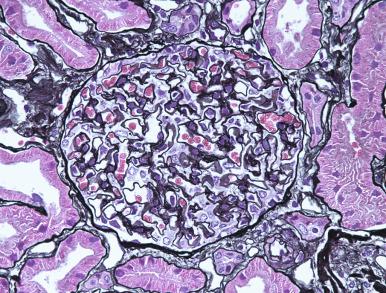
The characteristic ultrastructural appearance of the glomeruli is of total foot process effacement with the basement membrane being covered by sheets of cytoplasm. Loss of the visceral epithelial processes is accompanied by distortion of the filtration slits, with a decrease in the number of slit diaphragms. Visceral epithelial cells/podocytes show prominent intracytoplasmic organelles, suggesting increased cytoplasmic activity, and frequently contain cystoplasmic cysts/vacuoles. Numerous microvilli (i.e., villous projections of podocyte cytoplasm into urinary space) are often seen in MCD ( Fig. 23.5 ). There is a frequent increase in the density of the cytoskeleton, especially actin filaments, in the cytoplasm adjacent to the basement membrane, but no electron-dense deposits are present. Lower degrees of podocyte foot process effacement maybe observed in MCD patients with partial response to therapy.

Immunofluorescence studies are almost invariably negative for immunoglobulin and complement, but small amounts of IgM and C3 can occasionally be seen in cases with mesangial prominence. Albumin can be demonstrated as fine droplets in the cytoplasm of the proximal tubule cells when the tissue is stained for this protein ( Fig. 23.6 ).
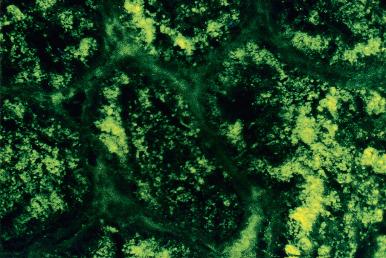
Because a biopsy is susceptible to sampling error, it should be kept in mind that lesions that affect only some glomeruli, such as FSGS, can lead to a misdiagnosis of MCD. Conversely, since tubular atrophy (TA) and interstitial scarring are not features of MCD, a diagnosis of FSGS should be considered if these findings are seen on a biopsy, especially in a child. It has been recently proposed that reduced expression of dystroglycan and CD44 observed in MCD can help differentiate it from FSGS, but further confirmation is needed.
FSGS, as a disease entity, is a clinicopathologic syndrome characterized by proteinuria, commonly in the nephrotic range, a high incidence of progressive renal failure, and focal and segmental sclerotic glomerular lesions. The segmental sclerosis results from an increase in mesangial matrix, causing obliteration of the glomerular capillaries. Five histologic subtypes have been described, including collapsing variant, “tip” lesion, cellular variant, perihilar lesion, and FSGS-NOS (not otherwise specified) variant. This histologic classification is hierarchical and is referred to as “Columbia classification of FSGS.” The presence of even a single collapsing lesion qualifies for a diagnosis of collapsing variant of FSGS. In the absence of a collapsing FSGS lesion, a “tip lesion,” if present, trumps other variants. The next lesion in the hierarchy is cellular FSGS, followed by perihilar and NOS variants. Although the FSGS lesion identified in the biopsy may change over time in an individual patient, these morphologic variants do have clinical relevance. The patients with collapsing FSGS have poor outcomes while patients with a “tip” variant respond well to immunosuppressive therapy, akin to MCD. Perihilar variants often point to a structural adaptive response to renal parenchymal loss or glomerular hyperfiltration due to a variety of other etiologies; the renal presentation is usually subnephrotic proteinuria rather than a full nephrotic syndrome as would be more common with collapsing and tip variants.
From an etiologic standpoint, FSGS may be primary or secondary to various forms of injuries or pathogenic mechanisms. The morphologic variants of FSGS are not helpful in distinguishing primary from secondary FSGS and a biopsy diagnosis of FSGS should prompt an evaluation of etiology. The pathogenesis of primary FSGS is unknown, but it appears to be the result of circulating “permeability” factor(s), possibly a lymphokine or a cytokine, which leads to epithelial cell injury resulting in segmental scar and ultimately glomerular obsolescence. The potential circulating permeability factors include cardiotrophin-like cytokine 1 and urokinase plasminogen activator receptor, but they have not been shown to be entirely sensitive or specific.
FSGS can be secondary to a variety of conditions including drugs, viral infections, healed glomerulonephritis, and structural adaptive responses. In addition, genetic associations with either autosomal dominant or recessive mode of inheritances are being increasingly recognized as a cause of FSGS. Mutations have been detected in several podocyte genes encoding proteins in the slit diaphragm, cytoskeleton, mitochondria, transcription, and DNA repair. Several patients with FSGS who would have been previously categorized as a “idiopathic” FSGS might in fact have a genetic form of FSGS. Even in cases without a single gene mutation, there appears to be a familial susceptibility to developing FSGS. Recent studies have established a strong association between apolipoprotein L1 (APOL1) gene and FSGS in blacks. The risk alleles G1 and G2 are more commonly seen in blacks and are also linked to higher rates of progressive kidney disease. The APOL1 gene product is expressed in podocytes and platelets and although the exact mechanism of kidney disease causation is unknown, the risk alleles appear to confer an evolutionary protection against Trypanosoma brucei infections.
The glomerular lesion of secondary FSGS can be histologically identical to that seen in primary FSGS and can occur in a variety of clinical settings with a clinical presentation indistinguishable from that of primary FSGS. Since the pathogenetic mechanisms involved in these disorders and their treatment differs significantly from that of primary FSGS, it is of paramount importance that they be excluded before a diagnosis of primary FSGS is made. In Box 23.2 are listed the conditions most commonly associated with FSGS which should be excluded before making the diagnosis of primary FSGS.
Primary (idiopathic) FSGS
Secondary FSGS
Genetic
Mutations in podocyte genes NPHS1 (nephrin), NPHS2 (podocin), PLCE1 (phospholipase C ε1), ACTN4 (α-actinin 4), CD2AP (CD2-associated protein), WT1 (Denys–Drash syndrome),
Mutations in basement membrane genes COLA3, COLA4 (Alport syndrome), genes encoding β 4 integrin and laminin β 2
Mitochondrial cytopathies
Others
Viral infections
HIV-1, parvovirus B19, cytomegalovirus, simian virus 40, Epstein–Barr virus
Drugs
Heroin, interferon α and β, lithium, bisphosphonates, sirolimus, calcineurin inhibitors, anabolic steroids
Glomerulonephritis
Healed focal segmental glomerular lesions
Mediated by adaptive-functional responses
Reduced renal mass and/or nephrons : unilateral renal agenesis, dysplasia/hypoplasia, oligomeganephropenia, prematurity/low birth weight, partial cortical necrosis, surgical renal ablation, reflux nephropathy, any advanced renal disease with reduction in functional nephrons
Initially normal renal mass : hypertension, morbid obesity, cyanotic congenital heart disease, glycogen storage diseases, sickle cell anemia
Primary FSGS is responsible for approximately 10%–15% of the cases of nephrotic syndrome in children and 20%–30% in adults. It constitutes the predominant cause of idiopathic nephrotic syndrome in adult patients, especially in blacks. Nephrotic range proteinuria is common and the clinical manifestation can be an abrupt onset of nephrotic syndrome or insidious onset of subnephrotic proteinuria. Examination of the urinary sediment will often lead to the detection of microscopic hematuria. Forty to 60% of patients have been shown to develop end-stage renal disease (ESRD) within 10–20 years, and recurrence following transplantation has been reported in 30%–40% of patients, often within weeks, leading to graft loss. The response to steroid therapy is limited, often prompting a second line of aggressive immunosuppressive therapy and plasmapheresis that aids the removal of the circulating permeability factor.
Pathologically, in primary or secondary FSGS, the segmental sclerosis, collapse, or obliteration of capillary lumen (i.e., depending on the morphologic variants) usually affects one or more lobules of the glomerular tuft. Early lesions may show an increased mesangial matrix and mild mesangial hypercellularity; only when the sclerosis is advanced do these areas become hypocellular, often with adhesions to the Bowman capsule ( Fig. 23.7 ). The visceral epithelial cells can line the sclerotic segments and these adhesions, and hence the term “podocyte capping.” The loops in the sclerosed areas are distorted, and they may contain hyaline material (hyalinosis), which is thought to represent plasmatic insudation, and lipid-laden “foam” cells. These findings in the absence of collapsing, cellular and tip variant features (described later) and present in a nonperihilar distribution define a FSGS-NOS subtype.
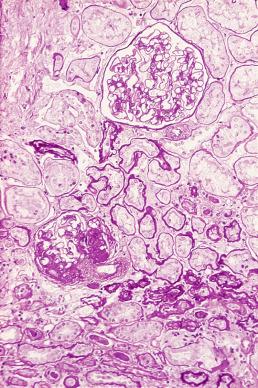
On occasion, sclerosis or consolidation is seen in the portion of the glomerulus opposite the hilus forming an adhesion in the vicinity of the opening of the Bowman space into the proximal tubule (glomerular tip lesion). The consolidated portion of the capillary tuft in “tip” lesion may display endothelial swelling and entrapped foam cells ( Fig. 23.8 ). The visceral epithelial cells overlying the involved segment are enlarged and vacuolated and often contain intracytoplasmic hyaline droplets. Some lesions are less cellular with an increase in mesangial matrix. The sclerotic segments in “perihilar” variant are localized next to the vascular pole, and it is a typical finding in secondary forms of FSGS attributable to adaptive functional response. The most controversial and least common subtype is the “cellular” variant in which the segmental lesion demonstrates intracapillary hypercellularity, and sometimes foam cells and karyorrhexis; hyperplasia of overlying podocytes is quite common. The collapsing FSGS lesion is described in detail in the subsequent section.
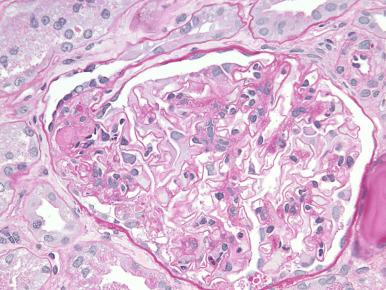
The extent of capillary tuft affected by sclerosis increases with eventual global sclerosis as the disease progresses. Areas of TA are common, and while this finding is not by itself diagnostic of FSGS, it should raise the possibility in biopsies which otherwise show MCD. Interstitial fibrosis (IF) accompanies tubular loss and atrophy, and the extent of the tubulointerstitial damage is a prognostic indicator of the disease. Since the glomerular injury in FSGS typically begins in the corticomedullary region, the lesion can be missed if this population of glomeruli is not included in the biopsy.
As FSGS represents podocyte injury, the most significant ultrastructural feature to be evaluated is podocyte foot process effacement, especially in capillary loops (and glomeruli) unaffected by sclerosis. Extensive podocyte foot process effacement is a feature of primary FSGS and is often seen in collapsing, tip, and cellular FSGS subtypes. Some secondary forms of FSGS and perihilar morphologic variants typically have less degree of foot process effacement. A variable increase in mesangial matrix is customary in all glomeruli, and some degree of mesangial hypercellularity is not uncommon. In sclerosed segments, the GBMs are often folded and focally thickened; on occasion, foci of podocyte cell membrane detachment from GBM are seen and intervening space can accumulate multilayered basement membrane–like material and cellular debris. The hyaline deposits are composed of finely granular material that has a similar appearance and electron density to that of the insudative material seen in diabetic nephropathy. These insudations are predominantly subendothelial and located in the areas of segmental sclerosis; immunofluorescence studies show that they contain IgM and C3 ( Fig. 23.9 ), but no immunoglobulin or complement deposition is seen in unaffected glomeruli.
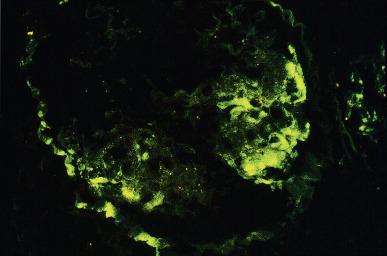
Collapsing glomerulopathy is a clinically and pathologically distinct variant of FSGS that is characterized by the widespread collapse of glomerular capillary loops, and predominance in blacks attributable to the APOL1 risk alleles. Patients usually present with abrupt onset of nephrotic syndrome or nephrotic range proteinuria and renal impairment. An idiopathic form of collapsing FSGS has poor prognosis with rapid loss of renal function and virtually no response to immunosuppressive therapy. A circulating permeability factor might be responsible as evidenced by a rapid recurrence in an allograft. Collapsing FSGS can be a secondary process associated with intravenous (IV) drug abuse and/or human immunodeficiency virus (HIV) infection. This variant of FSGS constitutes about 80%–85% of the glomerular changes reported in HIV-infected patients. Collapsing glomerulopathy has also been reported in association with some autoimmune diseases, lymphoproliferative disorders, drugs such as bisphosphonates and interferons, severe allograft ischemia, and non-HIV viral infections, such as hepatitis C, cytomegalovirus, and parvovirus B19. Treatment of the underlying cause is helpful in inducing remission in these secondary forms.
The characteristic histologic feature is a predominantly collapsing type of focal glomerulosclerosis that is segmental and often global. The segmental sclerosis is characterized by localized hypertrophy and hyperplasia of the epithelial cells overlying the collapsed segment ( Fig. 23.10 ). These cells are often swollen and vacuolated and may contain abundant resorption droplets. The presence of even a single glomerulus with collapsing FSGS lesion is adequate for this diagnosis. The hyperplastic epithelial cells in this lesion represent either a proliferation of dysregulated podocytes or migrated parietal epithelial cell in response to injury. Relative to the extent of glomerular sclerosis, tubulointerstitial injury is more severe in collapsing glomerulopathy than in typical FSGS. The tubular epithelial cells may present degenerative changes and the tubular lumens are often markedly dilated and show extensive proteinaceous cast formation. The interstitium often exhibits a prominent inflammatory infiltrate mainly composed of lymphocytes.
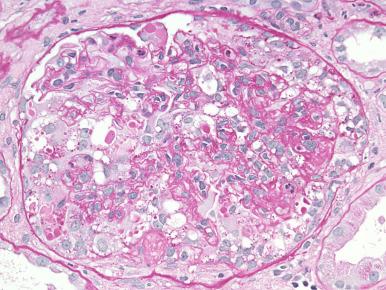
The most common immunofluorescence finding in the glomeruli in patients with collapsing glomerulopathy is IgM and C3 in a segmental distribution in the lesional glomerulus. Less commonly, C1q may also be localized. The podocyte protein resorption droplets are highlighted by IgG, IgA, and albumin. The changes seen by electron microscopy are generally those of typical FSGS, and the podocyte foot processes are extensively effaced. The GBM is diffusely wrinkled in areas of collapse. A distinctive but nonspecific feature is the finding of endothelial tubuloreticular inclusions in over 90% of patients with HIV-associated collapsing glomerulopathy. These structures are rarely seen in idiopathic collapsing glomerulopathy or in collapsing glomerulopathy associated with other causes. Numerous endothelial tubuloreticular inclusions are also seen in patients with systemic lupus erythematosus (SLE) or in patients treated with interferon alpha.
C1q nephropathy is a relatively uncommon and controversial immune complex–mediated glomerulopathy that is characterized by the presence of dominant or codominant C1q deposition in the mesangium. Patients may present with nephrotic syndrome or mild proteinuria with or without hematuria. The condition typically affects adolescents and young adults and appears to be more common in blacks than in whites. C1q nephropathy with normal histology or mesangial proliferation responds to corticosteroids, but FSGS histology is associated with poorer outcome. Progression to renal failure is slow, and it has been estimated that the 5-year renal survival rate is about 78%. It is not entirely clear as to whether C1q nephropathy is a specific clinical entity or is part of the clinicopathologic spectrum of MCD and FSGS.
Light microscopic findings vary from slight to marked mesangial hypercellularity with an increase in mesangial matrix, with or without segmental glomerulosclerosis. Electron microscopy studies invariably demonstrate mesangial immune complex deposits. Subendothelial or subepithelial deposits are uncommon. On immunofluorescence, C1q is often accompanied by IgG, IgM, and C3; IgA has been reported in about 60% of the cases. The main differential diagnosis of C1q nephropathy is lupus nephritis which can also have prominent C1q deposition in the mesangium together with immunoglobulins and C3. Clinical presentation, serologic evidence, extraglomerular deposits, and presence of tubuloreticular inclusions help differentiate between class II lupus nephritis and C1q nephropathy.
MGN (a.k.a. membranous nephropathy) is a glomerular disease of diverse etiology characterized by subepithelial immune complex deposits and variable basement membrane thickening, without infiltration by inflammatory cells. MGN accounts for 20%–30% of all cases of idiopathic nephrotic syndrome in adults and 1%–9% in children. In large majority of cases, this condition occurs in a primary (“idiopathic”) form, but the disease has been related to a wide variety of conditions (secondary) in approximately 20%–25% of adults and 80% of children with MGN ( Box 23.3 ). Over 85% of cases of secondary MGN are caused by infection, neoplasia, or SLE. The most common causes worldwide are malaria and schistosomiasis, while SLE, neoplasia, hepatitis B infection, and drugs are the most frequent in the United States. Rare familial cases of MGN, probably related to a genetically transmitted mechanism, have been reported.
Autoantibodies to phospholipase A2 receptor (~80% of “primary” MGN)
Autoantibodies to THSD7A (~10% of “primary” MGN)
Systemic lupus erythematosus, mixed connective tissue diseases, Sjögren syndrome, rheumatoid arthritis, IgG4-related systemic disease, sarcoidosis, Hashimoto thyroiditis, Graves disease, Weber–Christian panniculitis, myasthenia gravis, bullous pemphigoid, autoimmune enteropathy, primary biliary cholangitis
Hepatitis B, hepatitis C, syphilis, Epstein–Barr virus, malaria, leprosy, tuberculosis, schistosomiasis, filariasis, hydatid disease, enterococcal endocarditis, brucellosis, staphylococcal infection
Carcinoma (lung, gastrointestinal tract, breast, prostate, kidney), seminoma, lymphoma (especially non-Hodgkin), leukemia, melanoma
Nonsteroidal anti-inflammatory drugs, D-penicillamine, bucillamine, anti-tumor necrosis factor agents, organic gold, probenecid, captopril, trimethadione, lithium, clomethiazole, diclofenac, hydrocarbons, formaldehyde, solvents, mercury
De novo MGN due to chronic antibody-mediated rejection, graft versus host disease in hematopoietic stem cell transplantation, neutral endopeptidase directed response in neonatal MGN, replacement therapy with recombinant aryl sulfatase and α-glucosidase
Sickle cell disease, diabetes mellitus, Kimura disease, sclerosing cholangitis, antiglomerular basement membrane disease, cryoglobulinemia, Guillain–Barré syndrome
MGN , Membranous glomerulonephritis; THSD7A , thrombospondin type-1 domain–containing 7A.
The pathogenetic mechanism that leads to the immune complex localization in the subepithelial aspect of the GBM, especially in primary forms, is being increasingly understood. Two mechanisms presumed responsible for the development and localization of the deposits along the GBM are that of in situ immune complex formation in the subepithelial capillary wall or that of circulating immune complexes being deposited in that location. Experimental studies suggest that in most cases, the immune complexes are formed in situ by the binding of circulating antibodies with antigens that are normally present in the glomerulus or with extrinsic antigens that have previously been planted as free antigens in the subepithelial area.
Primary human MGN appears to be largely an autoimmune disease with in situ glomerular immune complex formation. Over 70%–80% of primary MGN patients have autoantibodies directed against PLA 2 R expressed in podocytes and proximal tubules. These circulating PLA2R autoantibodies are IgG4 subtype and the plasma levels correlate with disease activity and therapeutic response, and may predict the risk of post-transplantation recurrence. Genome-wide association studies have strongly linked the disease to specific HLA-DQA1 and PLA2R alleles. Individuals with at risk polymorphisms may have increased propensity to present the autoantigen, precipitating MGN. Approximately 5%–10% of patients with primary MGN have autoantibodies (IgG4 subtype) to a recently described second podocyte antigen, thrombospondin type-1 domain–containing 7A (THSD7A), further expanding the role of autoimmunity in these patients.
In a subset of patients with MGN, alloimmune response appears to play a role in developing MGN. Neutral endopeptidase (NEP), expressed in podocytes and proximal tubular brush border, has been identified as the target antigen of antibodies deposited in the subepithelial space in patients with antenatal MGN. In these cases, it is likely that the anti-NEP antibodies produced by the mother are transplacentally transferred to her child with genetic deficiency of NEP. Some patients with Pompe disease and mucopolysaccharidosis IV receiving recombinant α glucosidase and aryl sulfatase B, respectively, also develop alloimmune responses resulting in MGN. Lastly, de novo MGN in allografts also appears to be an alloimmune response.
Conditions associated with secondary MGN include chronic infections, neoplasms, autoimmune diseases (SLE, rheumatoid arthritis, IgG4-related systemic disease), drugs, and sarcoidosis. Drugs commonly associated with MGN include nonsteroidal anti-inflammatory drugs, penicillamine, gold, lithium, mercury, captopril, and anti-tumor necrosis factor agents. In some instances of secondary MGN, hepatitis B antigens (HBsAg, HBcAg, and HBeAg), virus-like particles (hepatitis C), tumor antigens, thyroglobulin, and DNA-containing material have been identified in the immune complexes, but it is unclear if these antigens are indeed pathogenic. Exogenous antigen such as cationic bovine serum albumin (BSA) derived from milk has been identified within subepithelial deposits in young children with MGN. These children have no other evidence of milk allergy but have anti-BSA antibodies in circulation. Secondary forms of MGN typically lack circulating PLA2R, but a small subset of patients with hepatitis B, hepatitis C, malignant neoplasm, and sarcoidosis have circulating serum PLA2R. While this may be coincidental, it also raises the possibility that “primary” MGN is triggered by an underlying disease. In both primary and secondary forms, complement is activated at the capillary wall site and appears to have a role in the development of the proteinuria.
The incidence of MGN in different populations varies; there is a particularly high frequency in Japanese children and in certain African populations, probably related to a high incidence of hepatitis B infection and parasitic infestations. Although MGN may occur at any age, it is rare in children and adolescents. Eighty to 90% of the patients are over the age of 30 at the time of diagnosis, with a peak incidence in the fourth and fifth decades. The disease is twice as common in males. Sixty to 80% of patients have the nephrotic syndrome at onset, and others are usually referred for investigation of asymptomatic proteinuria or an abnormal urinalysis. The proteinuria is usually nonselective, but a highly selective proteinuria is seen in about 20% of cases. Macroscopic hematuria is rare, but as many as 90% of patients have microscopic hematuria at some time during the course of the disease. Hypertension is usually found after renal insufficiency has developed, but it can be seen in 30% of the patients at presentation. Rare cases with circulating anti-GBM antibody and/or antineutrophil cytoplasmic antibody (ANCA) have also been reported. Serum levels of C3, as well as other components of complement, are normal; however, if reduced, this suggests a secondary form of the disease.
The natural history and overall prognosis of MGN can be significantly affected by the underlying disease and the way it is treated. When MGN is secondary to drugs, toxic substances, or infections, removal of the etiologic agent will often result in the disappearance of the clinical symptoms and resolution of the renal lesion. The nephrotic syndrome may abate and the glomerular changes regress after resection and treatment of a malignant tumor. In patients with membranous lupus nephritis, the course is indolent, whereas those who develop a superimposed anti-GBM antibody disease undergo a rapid progression to renal failure. Most patients with primary MGN present with chronic proteinuria and have recurrent episodes of nephrotic syndrome persisting over many years. Only 20%–25% of these patients progress to renal failure terminating in ESRD. Partial or complete spontaneous remission has been reported in 20%–65% of cases. The likelihood of spontaneous remission is greatly increased in children and in patients who presented with proteinuria without the nephrotic syndrome and in whom the biopsy demonstrated a stage I glomerular lesion. Recurrence or de novo development of MGN after renal transplantation can occur. The recurrence rates have ranged from 10% to 30% in different series, while the de novo rate is more common, accounting for about twice as many cases of MGN in transplant recipients.
The structural features of the glomerular capillary wall have been used to define four histopathologic stages of the disease. In stage I , the glomeruli appear normal by light microscopy, and there are no significant changes in the thickness of the basement membrane. At this early stage, an incorrect diagnosis of MCD is possible if the biopsy is only studied by light microscopy. With the electron microscope, these cases show sparse immune complex deposits between the epithelial cell cytoplasm and the lamina densa of the basement membrane, but the latter appears homogeneous and uniform in thickness. The deposits can be irregular, dome shaped, or appear as small humps with a well-defined line between the lamina densa and the epithelial cell. Foot processes over the deposits are obliterated, but they often appear normal elsewhere ( Fig. 23.11 ).
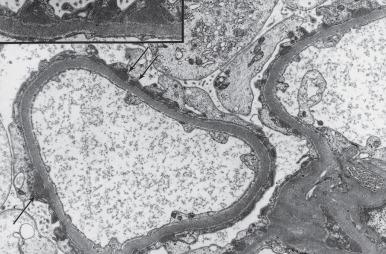
In stage II , the capillary walls are thickened and many subepithelial deposits are present, separated by extensions of basement membrane ( Fig. 23.12A ). The deposits do not stain with silver impregnation techniques, but the extensions of basement membrane do, thus creating the impression that the capillary loop is covered by spikes (see Fig. 23.12B ). These spikes have been shown to be composed of type IV collagen and noncollagenous extracellular matrix components, including laminin, heparan sulfate, proteoglycans, and vitronectin. The epithelial foot process effacement is extensive throughout the loops.
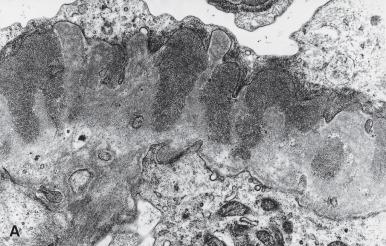
When the disease is more advanced ( stage III ), the deposits are encircled by a newly formed basement membrane ( Fig. 23.13 ). The capillary walls are markedly thickened and the capillary lumina narrowed. The basement membrane shows a reduplicated or moth-eaten appearance with PAS and silver stains. By electron microscopy, many of the deposits in stage III disease have a rarefied appearance that indicates resolution, and small spherical structures, which have been confused with virus particles, may be present during dissolution of the deposits. Individual deposits may also contain striated membranous bodies that are probably formed by degeneration of entrapped cellular components.
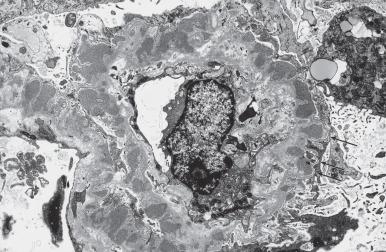
During the late stage of the disease ( stage IV ), deposits gradually lose their electron density and the basement membrane becomes vacuolated, folded, and thickened. Deposits may no longer be evident ( Fig. 23.14 ). Capillary lumina become obliterated, and the glomerular tufts show segmental or global sclerosis. TA and vascular sclerosis can be prominent, making the diagnosis difficult. In the end-stage of the disease, the differential diagnosis includes various types of chronic glomerulonephritis. Although the degree of proteinuria does not parallel the stages of the renal lesion, stage I carries a better prognosis than more advanced disease and spontaneous remission is more likely. However, there seems to be no difference in prognosis between stages II, III, and IV. Histologic progression can occur without clinical progression, and clinical remission can occur in the absence of histologic regression.
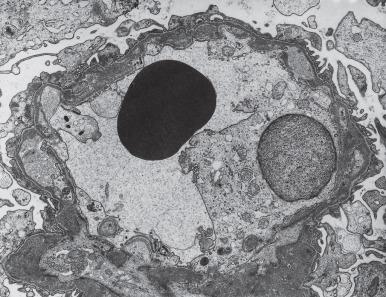
Immunofluorescence microscopy in all stages of MGN reveals a generalized, peripheral granular pattern of IgG, C3, kappa and lambda, sometimes with IgM ( Fig. 23.15 ). The reaction for IgA is usually absent, and if it is strong and associated with the early components of complement (C1q and C4), the possibility of lupus MGN must be considered. Although not evaluated on routine diagnostic studies, there is strong reactivity for terminal complement components (i.e., C5b–C9 membrane attack complex). Extraglomerular deposits have only rarely been reported in primary MGN. The finding of granular deposits along the tubular basement membrane (TBM) should always raise the possibility of membranous lupus nephritis. MGN with anti-TBM antibodies typically have linear TBM staining for IgG and sometimes with C3. Although not entirely sensitive or specific, with regards to IgG subclass staining, primary MGN deposits are mainly IgG4+, while membranous lupus nephritis deposits are positive for IgG1–IgG4 with IgG3 dominance. Primary MGN deposits stain for PLA2R by immunofluorescence microscopy and can be positive despite the lack of circulating antibodies as in early remission stage ( Fig. 23.16 ). Hence, renal biopsy is considered a sensitive tool for diagnosing primary MGN. Recurrent MGN in post-transplantation biopsies is also characterized by deposits that are IgG4 dominant and PLA2R positive. In contrast, de novo MGN deposits are IgG1 dominant and PLA2R negative. De novo MGN is often associated with chronic antibody-mediated rejection (AMR) and hence is considered an alloimmune phenomenon.
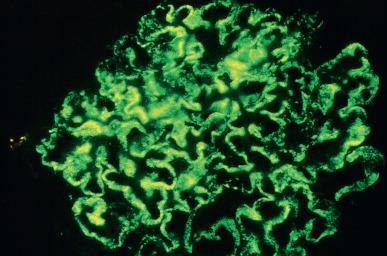

Notable morphologic characteristics of MGN throughout its evolution are the absence of mesangial hypercellularity and a lack of inflammatory cells within the glomeruli. On occasion, however, mesangial hypercellularity can occur, especially in patients with secondary forms of MGN, such as SLE, hepatitis B, or gold- or penicillamine-associated disease. In addition to epimembranous and intramembranous deposits, small amounts of immune complex deposition may be seen in the mesangial and/or subendothelial areas. Margination of leukocytes in the glomerular capillaries may be an indication of renal vein thrombosis. Crescent formation is uncommon and if focal, should suggest secondary MGN (e.g., due to SLE) or a superimposed disease. Diffuse fulminant crescentic disease is a rare and late consequence of the superimposition of anti-GBM or ANCA disease. Rarely, patients with MGN have tubulointerstitial nephritis (TIN) because of antitubular basement membrane antibodies. These patients are almost invariably children, present with nephrotic syndrome and Fanconi syndrome and progress to ESRD.
Diabetic nephropathy is a clinical syndrome characterized by persistent proteinuria, hypertension, and progressive decline in renal function. It is considered to be the leading cause of ESRD, accounting for approximately 40% of the new cases in the United States undergoing long-term dialysis. It is estimated that 20%–40% of all diabetic patients will develop diabetic nephropathy. In type 1 diabetes, the cumulative incidence of diabetic nephropathy is about 25% after 25–40 years of disease. Evidence suggests that the risk of overt nephropathy and progression to ESRD is similar in type 2 diabetes. Microalbuminuria is the earliest manifestation of diabetic nephropathy but cannot be detected by standard urine dipstick method. Proteinuria, usually of nonselective type, is the most consistent overt manifestation of diabetic nephropathy. The nephrotic syndrome has been reported in 6%–40% of the cases and constitutes a sign of poor prognosis. About 28%–48% of patients may present with moderate microscopic hematuria. Hypertension is a late complication seen with advanced renal failure. The rate of progression to end-stage kidney disease is dependent on a variety of factors including genetics, environmental factors, therapeutic interventions, and comorbidities. Blacks and Native Americans with type II diabetes mellitus are at greater risk of developing diabetic nephropathy.
The development of diabetic nephropathy is related to multiple factors, and inadequate glycemic control is one of the most important. Persistent hyperglycemia causes accumulation of advanced glycosylated end products in various organs including kidney with resultant injury, tissue remodeling, and extracellular matrix deposition. It also causes defects in mitochondrial electron transport, increased production of reactive oxygen species, and increased oxidative stress. Many cellular proteins, including GBM collagen and matrix proteins, are affected. Inherited risk factors such as certain polymorphisms in genes involved in the renin angiotensin system and insulin resistance appear to play a role.
Diabetic microangiopathy occurring throughout the body is the most characteristic morphologic change in the diabetic, and its hallmark is an increase in the amount of vascular basement membrane material. There are no significant morphologic differences in the renal lesions caused by type 1 and type 2 diabetes. All areas of the kidney may be affected by diabetes, but the most striking lesions are found in the glomeruli and blood vessels, including diffuse glomerulosclerosis, nodular glomerulosclerosis, and the so-called insudative lesions (fibrin caps, capsular drops, and arteriolar hyalinosis). Diabetic glomerulosclerosis is the general term for all of these lesions, and they are considered to be an expression of the microangiopathy.
Diffuse glomerulosclerosis, the most common lesion in diabetic nephropathy, is characterized by a diffuse increase in the mesangial matrix and thickening of the capillary walls ( Fig. 23.17 ). Thickening of the GBM is the most consistent finding in diabetic nephropathy and is often seen in both diffuse and nodular glomerulosclerosis. Although minor degrees of basement membrane thickening are not specific for diabetes, measurement of the basement membrane width is the most effective way to quantitate early diabetic glomerular lesions. In advanced stages, the GBM may be many times its normal thickness, often with accentuation of the normal fibrillar structure. The GBM thickening and mesangial changes can be seen by electron microscopy before the damage is visible by light microscopy. The earliest structural alteration in diabetic glomerulopathy that can be quantified is increased thickness of the GBM, which can be documented as early as 1.5–2.5 years after the onset of type I diabetes mellitus. A clear increase in the mesangial matrix and cellularity can be detected on light microscopy as early as 5–7 years after the onset of diabetes mellitus or within 2–5 years following renal transplantation. Recently, a histologic classification of diabetic nephropathy has been proposed, but its clinical utility has not yet been validated.
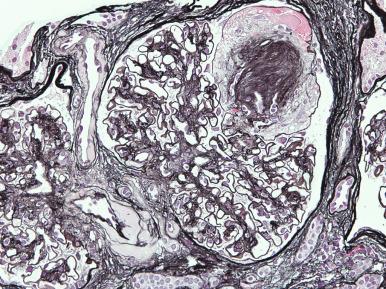
Nodular glomerulosclerosis (Kimmelstiel–Wilson lesion) is the characteristic histopathologic lesion in diabetic glomerulosclerosis. It consists of large acellular nodules located in the intercapillary regions (see Fig. 23.17 ). These nodules vary in size and often have a laminated appearance. They are eosinophilic, argyrophilic, and PAS positive and blue with trichrome stain. Ultrastructurally, the nodules are composed of masses of extracellular mesangial matrix ( Fig. 23.18 ). Both the mesangial widening and the nodules are the result of an increase in the synthesis and/or decrease in the degradation of the mesangial matrix. The capillary loops that surround the nodules may have narrow lumens because of the expansion of the mesangium, but they can also be aneurysmally dilated and some have peripheral mesangial extensions. Focal areas of mesangiolysis may also be present. Diffuse and nodular diabetic glomerulosclerosis can be found together, not only in the same patient, but also in the same glomerulus. Although nodular glomerulosclerosis is virtually pathognomonic of diabetic nephropathy, identical light microscopic lesions can be found in cases of light chain deposition disease (LCDD). In the latter condition, however, the nodules are composed of granular electron-dense material that shows light chain restriction with antibodies to kappa and lambda light chains. Nodular glomerulosclerosis mimicking diabetic nephropathy has rarely been reported in patients without manifested diabetes, but with longstanding hypertension and/or smoking history, and is referred to as “idiopathic” nodular glomerulosclerosis. Diffuse nodular deposits of amyloid can sometimes be confused with diabetic glomerulosclerosis by light microscopy, but the ultrastructural identification of amyloid fibrils will establish the diagnosis.
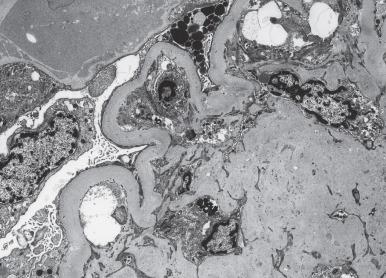
Insudative lesions are the least specific of the glomerular changes in diabetes. Ultrastructurally, they are seen to be masses of electron-dense material, often containing lipid droplets. Common locations of these lesions are the periphery of the loop in a subendothelial location (fibrin caps), within the basement membrane of the Bowman capsule (capsular drops), or in the mesangium or GBM. In blood vessels, they are more extensive in the subintima and media but can also involve the adventitia. This insudative lesion, known as hyalinosis, can affect the afferent and efferent arterioles and may ultimately replace the smooth muscle cells. The severity of the arteriolar hyalinosis correlates significantly with the percentage of sclerosed glomeruli, suggesting that the vascular lesion contributes to the ischemic global glomerulosclerosis. Histochemical and immunofluorescence studies indicate that the insudative material represents infiltration by constituents of the plasma, including proteins, lipids, and mucopolysaccharides.
Atubular glomeruli can also be found in diabetic glomerulosclerosis as a late manifestation of the disease, predominantly in patients with proteinuria. Atubular glomeruli are defined as those glomeruli that have open glomerular capillaries but have lost their connection with the proximal tubule and are presumably nonfunctioning. Although accurate identification of these glomeruli requires serial sections, small glomeruli surrounded by tissue with marked tubular loss are most probably atubular.
The most characteristic tubular change is diffuse thickening of the tubular basement membrane. When the disease is advanced, there is also TA and interstitial scarring that may be accompanied by chronic inflammatory infiltrate. The presence of interstitial neutrophils or tubular neutrophil casts should raise concern for superimposed acute pyelonephritis. Glycogen vacuolization of the renal proximal tubular epithelial cells (Armanni–Ebstein lesion), associated with uncontrolled hyperglycemia, was common in the past, but is rarely seen today. Approximately a third of renal biopsies with diabetic nephropathy have superimposed glomerular disease, and this list includes membranous nephropathy, IgA nephropathy (IgAN), postinfectious glomerulonephritis (especially IgA-dominant variant described later), and others. Cellular crescents are rare in diabetic glomerulosclerosis, but foci of organizing fibroepithelial crescents occur with superimposed ANCA-mediated glomerulonephritis, and their presence is associated with aggressive clinical course.
Diffuse linear reaction for IgG along the glomerular capillary, tubular, and Bowman capsular basement membranes is the most characteristic immunofluorescence finding in diabetic nephropathy ( Fig. 23.19 ). Less intense reaction in a similar distribution may also be seen for IgM, fibrin, and albumin, but staining for C3, if present, is often granular. These linear reactions are unrelated to either the duration or the severity of the glomerular lesions and evaluation studies do not show specific antibody activity to basement membrane antigens. Insudative lesions may react with a variety of reagents but most frequently contain IgM and C3.
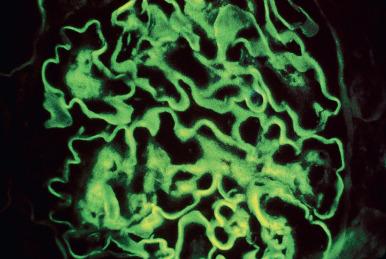
The term amyloidosis designates a heterogeneous group of disorders characterized by the extracellular deposition of nonbranching linear fibrils with a mean diameter of 10 nm and a β-pleated sheet configuration on x-ray diffraction analysis. It is this configuration that is responsible for the tinctorial and optical characteristics seen on Congo red staining, which produces the typical apple-green birefringence seen on tissue sections when they are examined under polarized light. Amyloid itself does not have a consistent chemical composition but is instead a group of proteins that share common physical characteristics. At present, more than 30 structurally unrelated proteins have been identified as amyloid precursors associated with human disease, but most forms are localized with rare or no involvement of kidney ( Table 23.3 ). In addition to the fibrillary protein, amyloid deposits contain nonfibrillary proteins, including glycosaminoglycans, apolipoprotein E (Apo E), and amyloid P component. The amyloid P component (also known as serum amyloid P or SAP) is a 25-kDa glycoprotein member of the pentraxin family that includes C-reactive protein. Amyloid P component is present in all types of amyloid, accounting for about 15% of their mass. It is believed that amyloid P component may prevent degradation of the amyloid fibrils once they are formed. Better understanding of the amyloid fibril composition, formation, and stabilization has helped the emerging field of targeted therapies in amyloidosis.
| AMYLOID PROTEIN | PRECURSOR PROTEIN | DISTRIBUTION | RENAL BIOPSY FEATURES OR ASSOCIATED CONDITION |
|---|---|---|---|
| Neoplasm-Associated (AL) Amyloidosis | |||
| AL | Immunoglobulin light chain | Systemic or localized | Glomerular, interstitial, and vascular deposits; multiple myeloma, B-cell lymphoma |
| AH | Immunoglobulin heavy chain | Systemic or localized | Glomerular, interstitial, and vascular deposits; multiple myeloma, B-cell lymphoma |
| Chronic Inflammation-Associated Amyloidosis | |||
| AA | (Apo) serum AA | Systemic | Chronic infections or inflammation. Seen in hereditary inflammatory syndromes (Familial Mediterranean fever, hyper-IgD syndrome, familial cold urticarial, Muckle-Wells syndrome) |
| Hereditary (or Mutation Associated) Amyloidosis | |||
| ATTR | Transthyretin | Systemic | Predominantly glomerular deposits or limited to medullary interstitium |
| AApoAI | Apolipoprotein AI | Systemic | Arterial and medullary interstitial deposits in kidney; localized deposits in aorta, meniscus |
| AApoAII | Apolipoprotein AII | Systemic | Medullary interstitial and vascular deposits |
| AGel | Gelsolin | Systemic | Glomerular deposits |
| ALys | Lysozyme | Systemic | Glomerular and vascular deposits |
| AFib | Fibrinogen alpha-chain | Systemic | Only glomerular deposits that stain for fibrinogen |
| ACys | Cystatin C | Systemic | Cerebral vessels (no renal involvement) |
| ALECT2 | Leukocyte chemotactic factor 2 | Localized | Glomerular, cortical interstitial and vascular deposits. No mutation, only a common polymorphism in LECT2 gene identified |
| ABri | ABriPP | Systemic | Familial dementia |
| Other Types of Amyloid Deposition | |||
| AApoAIV | Apolipoprotein AIV | Systemic | Sporadic, associated with aging |
| ATTR | Transthyretin | Systemic | Nonfamilial senile form |
| Aβ 2 M | β 2 -Microglobulin | Systemic or localized | Hemodialysis associated; localized form in joints |
| ADan | ADanPP | Localized | Familial dementia (Danish type) |
| Aβ | Aβ protein precursor (AβPP) | Localized | Alzheimer disease, associated with aging |
| APrP | Prion protein | Localized | Spongiform encephalopathies |
| ACal | (Pro) calcitonin | Localized | Medullary thyroid carcinoma |
| AIAPP | Islet amyloid polypeptide | Localized | Islet of Langerhans; Insulinomas |
| AANF | Atrial natriuretic factor | Localized | Cardiac atria |
| APro | Prolactin | Localized | Aging pituitary, Prolactinomas |
| AIns | Insulin | Localized | Iatrogenic |
| AMed | Lactadherin | Localized | Senile aortic, arterial media |
| AKer | Kerato-epithelin | Localized | Cornea, familial |
| ALac | Lactoferrin | Localized | Cornea (trichiasis) |
| AOaap | Odontogenic ameloblast-associated protein | Localized | Odontogenic tumors |
| ASemi | Semenogelin I | Localized | Seminal vesicle |
| ATau | Tau | Localized | Alzheimer disease, frontotemporal dementia, aging, other cerebral conditions |
The classification of amyloidosis is based on the type of precursor protein that forms the amyloid fibrils and the distribution of the amyloid deposits as to whether it is systemic or localized (see Table 23.3 ). By convention, the amyloid fibril type is designated A for amyloid, followed by an abbreviated form of the name of the fibril protein. Amyloid light-chain (AL) amyloidosis (formerly known as “primary” or “associated with multiple myeloma”) is the most common form of systemic amyloidosis in the Western world. In this type of amyloidosis, the amyloid fibrils are composed of the N-terminal residues of the variable region of an immunoglobulin light chain. The specific amino acid sequences and post-translational modifications of light chains confer the amyloidogenicity. A minority have overt multiple myeloma, while others have monoclonal spike in the serum and/or urine. The amyloidogenic light chains are more frequently lambda than kappa type, in contrast to normal or cast nephropathy light chains. Rarely, the amyloid deposits are derived from monoclonal immunoglobulin light and heavy chains or just heavy chains, and the disease is referred to as AHL amyloidosis or AH amyloidosis, respectively.
Amyoid A (AA) amyloidosis (formerly known as secondary amyloidosis) is a rare complication of persistent inflammation that may develop in patients affected by chronic rheumatic diseases, long-lasting infections, inflammatory bowel disease, periodic fever syndromes, familial Mediterranean fever, and malignancies. It is the most common type of amyloidosis in the parts of developing world with endemic tuberculosis and leprosy. In this type of amyloidosis, the AA amyloid deposits are formed by the N-terminal proteolytic fragments of the acute-phase reactant serum amyloid A (SAA), a polymorphic apolipoprotein of high density that, upon chronic inflammatory stimuli, may reach persistently high plasma concentrations. Certain polymorphisms in SAA gene appear to confer increased risk of developing AA amyloidosis in patients.
Hereditary systemic amyloidosis is a diverse group of autosomal dominant, late-onset (sometimes sixth or seventh decade of life) disorders that occurs much less frequently than AL or AA amyloidosis. These amyloidoses are caused by mutations in the genes coding for some plasma proteins, including transthyretin, apolipoprotein A-I, apolipoprotein A-II, apolipoprotein A-IV, fibrinogen A α-chain, gelsolin, cystatin C, and lysozyme. Specific amino acid substitutions allow each of these soluble circulating proteins to be prone to aggregate and form amyloid fibrils in organs and tissues. The natural history of these conditions varies by the protein, as well as the tissue distribution. For example, transthyretin amyloidosis, which is the most common form of hereditary systemic amyloidosis, typically affects the peripheral and autonomic nervous systems, manifesting as progressive sensory–motor neuropathy, gastrointestinal and bladder dysfunction, impotence, and orthostatic hypotension, whereas apolipoprotein A-I, apolipoprotein A-II, apolipoprotein A-IV, fibrinogen α-chain, and lysozyme amyloidosis are more often associated with a marked visceral burden of amyloid that clinically results in progressive kidney and liver disease.
Familial Mediterranean fever is a common form of the nephropathic familial amyloidoses. The deposits of amyloid in this condition consist of amyloid AA, and, in contrast to other forms of familial amyloidosis which are autosomal dominant, familial Mediterranean fever is associated with autosomal recessive inheritance. Mutations in MEFV gene encoding pyrin/marenostrin result in activation of IL-1β pathway with subsequent elevations of SAA levels, especially during febrile episodes. Other related periodic fever syndromes due to mutations in genes encoding cryopyrin, and tumor necrosis factor also cause autoinflammation with eventual precipitation of AA amyloid.
A subtype of amyloidosis of ill-defined etiology is ALECT2, characterized by accumulation of leukocyte chemotactic factor 2. No mutation in LECT2 gene has been identified, but all sequenced cases show a specific polymorphism. Produced in the liver, LECT2 is a plasma cytokine that increases the phagocytic and bacteriocidal activity of macrophages. ALECT2 is typically seen in elderly individuals of Mexican ancestry, although other ethnic populations can be affected. These patients often have comorbidities such as diabetes mellitus and hypertension.
Another form of amyloidosis is dialysis-related amyloidosis , a serious complication in patients undergoing long-term dialysis that is caused by the deposition of fibrillar β 2 -microglobulin (amyloid β 2 M). This type of amyloid has a predilection for musculoskeletal deposition. β 2 -Amyloid can cause carpal tunnel syndrome and a destructive arthropathy of medium-sized and large joints, especially of the shoulders and knees. Visceral amyloid deposition occurs late, usually after 15 years of hemodialysis, and may involve the heart, liver, lungs, and gastrointestinal system. End-stage kidneys may also be involved by β 2 -microglobulin amyloidosis, but this has no clinical significance.
Nonselective proteinuria, with or without the nephrotic syndrome, is the most common manifestation of renal involvement by amyloidosis. Approximately 25% of the patients with AL amyloidosis have the nephrotic syndrome at diagnosis, and a total of about 40% will develop the syndrome during the course of the disease. Over 90% of patients with AA amyloidosis have renal insufficiency or nephrotic syndrome at diagnosis; however, the degree of proteinuria does not correlate with the extent of the amyloid deposition in the kidney. The prognosis for a patient with renal amyloidosis is poor, especially in those with AL amyloidosis.
Because the kidney is frequently affected in AL, AA, and several familial amyloidoses, a kidney biopsy is often a method by which the disease is identified. Amyloid can be found anywhere in the kidney but especially accumulates in glomeruli. Deposition is initially mesangial, producing diffuse widening of axial areas but progressively involves the capillary walls ( Fig. 23.20A and B ). Substantial mesangial deposition can produce nodules that may resemble those of diabetic glomerulosclerosis or LCDD. However, in amyloidosis, because the nodules are composed of amyloid protein rather than mesangial matrix, PAS staining is weak and trichrome stain is grayish blue in mesangium. Diffuse spread throughout the glomerulus can produce a picture reminiscent of membranous nephropathy, especially with the formation of basement membrane spicules. Amyloid deposition in the tubulointerstitium produces TA and IF, and in a small percentage of patients (~10%), the glomerular deposits are absent and amyloid is restricted to the tubulointerstitium or blood vessels. Several differences have been described in the distribution of amyloid deposits in various subtypes. For example, ALECT2 primarily affects cortical interstitium along with glomeruli and blood vessels, but the medulla is spared; AFib-α exclusively involves glomeruli and AApoAI/AII/AIV affects medullary interstitium with relative glomerular sparing. Histochemical techniques used for the diagnosis of amyloid include Congo red and thioflavin T stains ( Fig. 23.21A and B ). Thioflavin T is extremely sensitive but not entirely specific, whereas the production of an apple-green color by polarized light in Congo red–stained sections is accepted as the most reliable light microscopic method for diagnosis. Each technique requires a critical amount of amyloid before a positive reaction can be elicited. Because of this, small amounts of amyloid may be missed and, even more important, neither technique is effective with very thin sections. The staining should be performed on sections cut at least 8 µm thick and always with appropriate controls. The fibrils of AL and AA amyloidosis can be distinguished by pretreating tissue sections with potassium permanganate before the Congo red staining. Under these conditions, AA amyloid fibrils lose their affinity for the Congo red stain, and the birefringence is lost, whereas AL amyloid is not affected. This technique, however, is not as reliable as immunostaining with currently available AA antibodies.
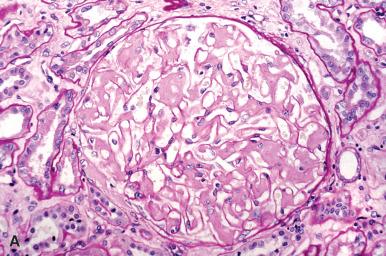
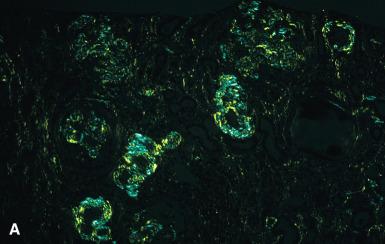
In the early stages of renal involvement when histochemical preparations fail to detect the deposits of amyloid, electron microscopy is the only method available to establish the diagnosis. Ultrastructurally, the amyloid fibrils in tissue sections form random aggregates of rigid, nonbranching fibrils measuring 8–10 nm in diameter ( Fig. 23.22 ). Initially, the amyloid is seen in mesangium and the deposition subsequently extends into the subendothelial zone and through the basement membrane. When amyloid penetrates the basement membrane, epithelial foot processes are effaced and are often separated from the membrane.
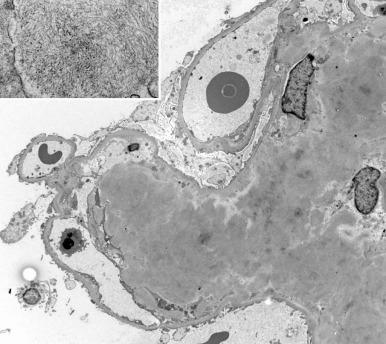
Because the amyloidogenic light chain in AL amyloidosis is produced by clonal plasma cells, immunofluorescence or immunoperoxidase studies will show restrictive immunoreactivity for either kappa or, more frequently, lambda light chain. It should be emphasized, however, that a negative reaction for both light chains does not exclude the diagnosis of AL amyloidosis. This is because the main constituent of amyloid deposits in some cases of AL amyloidosis is the light chain variable region alone and the commercially available antibodies are typically raised against the light chain constant region. Monoclonal heavy chain staining (IgG, IgA, or IgM) may instead be seen in AH amyloidosis or may be present in addition to light chain restriction, as in AHL amyloidosis. Sometimes the “stickiness” of amyloid causes nonspecific immunoglobulin staining and an erroneous subtyping of amyloid deposits. Amyloid A usually can be demonstrated by the currently available anti-AA protein antibodies. Since amyloid P component is present in all types of amyloid, it can be used as a pan-amyloid marker to highlight the extent of amyloid deposition. It is important to keep in mind, however, that amyloid P component is not specific for amyloid and is present in the organized deposits of immunotactoid glomerulopathy and in normal GBM and blood vessels ; therefore, a positive stain does not denote the presence of true amyloid deposition, and it is necessary to establish the presence of amyloid by a positive Congo red stain.
Other less common amyloid subtypes such as LECT2, ApoAI, ApoAII, and transthyretin can be characterized by performing immunohistochemical stains. However, the list of amyloid subtypes is quite extensive, and given the limited renal biopsy material, it is now standard of care to perform mass spectrometry on laser microdissected amyloid deposits on paraffin sections. Approximately 90% of renal amyloidosis cases belong to either AL or AA type. An initial panel of immunofluorescence and/or immunohistochemistry can be performed to evaluate for AL and AA amyloidosis and failure to subtype the amyloid with this initial testing should prompt mass spectrometry analysis.
Fibrillary glomerulonephritis is characterized by extracellular deposition of nonbranching, randomly arrayed fibrils approximately 10–30 nm in diameter. Reported in just 0.5%–1.0% of the cases in three large series of native kidney biopsies, it most commonly affects middle-aged adults but can also occur in older individuals and children as young as 10 years of age. It is more common in whites than in blacks (ratio 8.3 : 1) and affects females more often than males (1.8 : 1). Patients typically present with heavy proteinuria, often in the nephrotic range. Microscopic hematuria is common, but on occasion gross hematuria may occur. About 75% of patients develop hypertension, sometimes severe. Low serum complements are only rarely encountered in fibrillary glomerulonephritis. No specific serum or urine protein abnormalities have been recorded, and the patients have a low incidence of associated lymphoproliferative malignancy. The prognosis for patients with fibrillary glomerulonephritis is poor. Roughly half of these patients progress to ESRD within 2 years of the initial diagnosis. Fibrillary glomerulonephritis has been reported to recur in almost a third of the patients who undergo renal transplantation.
The light microscopic findings of fibrillary glomerulonephritis can be variable. Common features include mesangial hypercellularity, mesangial expansion with amorphous PAS-positive material, and thickening of the glomerular capillary walls ( Fig. 23.23A ). The overall appearance of the lesions can resemble mesangial proliferative, membranoproliferative, focal and diffuse proliferative, and MGN. Crescents are not uncommon and can occur in about one-fourth to one-third of cases. An important characteristic of these amorphous deposits is that they do not stain with Congo red or thioflavin T stains (thus differentiating them from amyloid fibrils) and they are observed in the absence of circulating cryoglobulins.
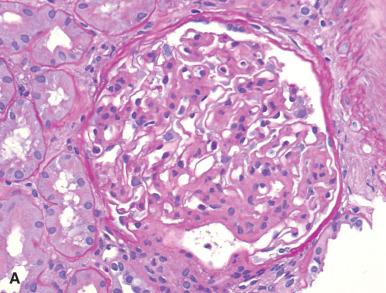
Ultrastructurally, the deposits can be found in all glomerular compartments, including the mesangium, GBM, and subendothelial and subepithelial areas. The fibrillary deposits in fibrillary glomerulonephritis are randomly oriented and measure 10–30 nm in diameter (see Fig. 23.23B ). In rare cases of fibrillary glomerulonephritis, fibrils have been reported in the peritubular capillary walls and in the tubular basement membrane. Patients usually exhibit extensive effacement of the podocyte foot processes, a finding that correlates with severe proteinuria observed in these patients. Immunofluorescence microscopy most often reveals IgG and C3 in a distribution that corresponds to the fibrillary deposits (see Fig. 23.23C ). On occasion, small amounts of IgM and IgA can also be seen. With regards to IgG subclasses deposited, IgG4 is the dominant one, often in combination with IgG1. Both kappa and lambda light chains are detected in most cases of fibrillary glomerulonephritis. Light chain restriction is seen in approximately 15% of patients with fibrillary glomerulonephritis.
Although initially described together with fibrillary glomerulonephritis, immunotactoid glomerulopathy is recognized as a distinct entity. When strict diagnostic criteria are used, immunotactoid glomerulopathy is exceedingly rare, occurring with only one-tenth the frequency of fibrillary glomerulonephritis. Although the clinical presentation of immunotactoid glomerulopathy is quite similar to that of fibrillary glomerulonephritis, these conditions differ in that immunotactoid glomerulopathy tends to occur in older individuals and is more likely to have an associated monoclonal gammopathy or lymphoproliferative malignancy, serum M-spike, and a worse long-term survival. Approximately 40% of immunotactoid glomerulopathy patients have associated hypocomplementemia suggestive of complement activation by pathogenic immunoglobulins. The light microscopy findings are variable and amorphous Congo red negative deposits are often seen in the mesangium and capillary walls. The immunotactoid deposits consist of microtubular structures with a hollow core ranging from 30 to 50 nm in width and arranged in parallel or stacked arrays. Vast majority of immunotactoid deposits (in 70%–90% of patients) are composed of monoclonal light chains, most often kappa type. When such monotypic deposits are seen in immunotactoid glomerulopathy, the IgG deposits often belong to IgG1 subclass.
LCDD is a rare systemic disorder caused by the overproduction and extracellular deposition of monoclonal immunoglobulin light chain. A minority of cases may also have heavy chain determinants, and these cases are regarded as having light and heavy chain deposition disease (LHCDD). On rare occasion, isolated heavy chain is deposited (HCDD, discussed later), and all these disorders with similar pathology constitute monoclonal immunoglobulin deposition disease (MIDD). Although the principal clinical manifestations are dominated by renal disease, patients may present secondary symptoms produced by cardiac, hepatic, or neural damage. In addition, abnormal light chains can be deposited in many other organs, including the skin, spleen, thyroid gland, adrenal glands, gastrointestinal tract, and lungs.
LCDD has many histologic features in common with AL amyloidosis; however, in contrast to amyloidosis where the deposits are fibrillar, LCDD deposits are granular, do not stain with Congo red or thioflavin T, and do not contain amyloid P protein. Also, while the deposits in amyloidosis consist mainly of lambda light chains, 80% of LCDD cases are composed of kappa light chains. The pathogenic light chains in LCDD have unique alterations in the complementarity-determining and framework portions of the variable region. Males are more frequently affected, with a ratio of approximately 2 : 1. About 60%–70% of the reported patients with LCDD have had well-documented multiple myeloma or another lymphoplasmacytic disorder at the time of, or subsequent to, the diagnosis of the nephropathy. Although 15%–20% of patients lack monoclonal light chains in serum or urine by immunofixation method, abnormal serum free light chain ratio is detectable in all patients with LCDD and LHCDD. Serum complement levels are typically normal unless associated with monoclonal heavy chains (as in LHCDD). LCDD occurs more frequently in middle aged to older individuals, but it has been reported in older children. Most patients present with renal failure associated with heavy and nonselective proteinuria, reaching nephrotic range in over a third. Concurrent cast nephropathy has been diagnosed in a third of patients with LCDD and the presenting feature is typically acute renal failure. Microscopic hematuria is common. Renal insufficiency can progress to an end-stage kidney disease, at which time the patient will require dialysis or renal transplant. Without effective treatment to reduce light chain production, LCDD almost invariably recurs after renal transplantation, and the recurrence may occur within weeks to years after transplantation. The prognosis for patients with LCDD is generally poor, and death is often attributed to cardiac disease or complications of infection. The 5-year survival is approximately 70% but is less if there is coexisting multiple myeloma or light chain cast nephropathy.
Affected glomeruli are enlarged, and the deposition of the markedly PAS-positive material produces capillary wall thickening and nodular expansion of the mesangium. The extent of glomerular involvement can vary in a biopsy from minimal mesangial expansion to a fully developed nodular glomerulosclerosis that resembles diabetic glomerulosclerosis, but other morphologic features characteristic of diabetes, such as severe arteriolar hyalinosis, fibrin caps, and capsular drops are absent ( Fig. 23.24 ). Although the pathogenesis of the glomerulosclerosis in LCDD is not entirely clear, experimental studies have shown that mesangial cells exposed to light chains obtained from a patient with LCDD produce transforming growth factor β (TGF-β), which triggers the production of matrix proteins, such as type IV collagen, laminin, and fibronectin. The tubular basement membranes are thickened and present a homogeneous glassy appearance. Light chain–restricted casts are found in rare cases with concurrent cast nephropathy, and a minority of patients have concurrent AL amyloidosis.
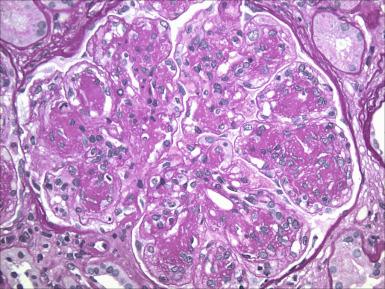
Immunofluorescence microscopy demonstrates linear staining of the monoclonal light chain along the glomerular and tubular basement membranes, as well as the vessel wall; mesangial deposits are also highlighted by the monoclonal light chain ( Fig. 23.25 ). Electron microscopy studies reveal a continuous deposition of a powdery electron-dense material in the GBM, the mesangium, and along the tubular and vascular basement membranes ( Fig. 23.26A ). Ultrastructurally, the material differs from dense deposit disease (DDD) in that it is finely granular, relatively homogeneous in thickness, and distributed along the inner aspect of the GBM and in the outer aspect of the tubular basement membrane (see Fig. 23.26B ).
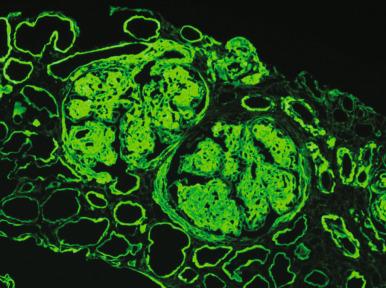
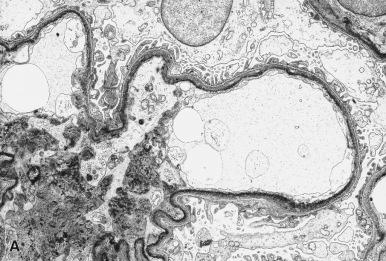
Heavy chain deposition disease (HCDD) is much less common than LCDD. It is characterized by systemic deposition of a monoclonal immunoglobulin heavy chain. The deposited heavy chain is gamma in most cases, and all subclasses of gamma heavy chain have been reported to participate in the disease. A deletion of the first constant domain (CH1) of the heavy chain has been reported in all documented cases and is likely necessary for the secretion of a free heavy chain by a plasma cell clone of HCDD. The clinical manifestations and histologic features of HCDD are quite similar to those of LCDD. In contrast to amyloidosis and LCDD, patients with HCDD often manifest hypocomplementemia, possibly due to the complement-fixing properties of IgG subclass deposited. The diagnosis of HCDD can be done by the immunofluorescent demonstration of positivity for heavy chains (usually gamma, IgG) and negativity for both kappa and lambda light chains. The reactivity for the heavy chain occurs along the glomerular, tubular, and vascular basement membranes and in the mesangium.
Proliferative glomerulonephritis with monoclonal immunoglobulin G deposits ( PGNMIGD) is a recently described, rare proliferative glomerular disease with monoclonal immunoglobulin G deposits. It is often seen in middle aged or older individuals, with a female predominance. Over two-thirds of these patients present with nephrotic syndrome and renal impairment, while others have less degrees of proteinuria and hematuria. Despite having monoclonal IgG deposits on kidney biopsy, monoclonal gammopathy is seen in less than 30% of patients and underlying multiple myeloma is rare. A minority of patients (~25%) have reduced serum complement levels, but there is no clinical or serologic evidence of connective tissue disorder or cryoglobulinemia. While some patients may respond to steroids or other immunosuppressive therapy such as rituximab, PGNMIGN is typically a slowly progressive kidney disease that recurs in allografts. The light microscopic findings are quite variable with membranoproliferative pattern being the most common; endocapillary proliferation, crescents, membranous, mesangioproliferative, and segmental sclerosis patterns have also been described. Immunofluorescence microscopy reveals granular mesangial and capillary wall deposits composed of IgG and C3 with associated light chain restriction (IgG3κ most common); IgM and C1q may sometimes be seen. PGNMIGD is defined by IgG subclass restriction and cannot be rendered without immunofluorescence microscopy analysis of IgG subclasses (IgG1–4). IgG3 deposition is most common (followed by IgG1) in PGNMIGD, and its frequent association with hypocomplementemia is possibly related to its complement-fixing abilities and nephritogenicity. Ultrastructural examination localizes the deposits to mesangium and subendothelium with occasional subepithelial deposits identified. Extraglomerular deposits and organized substructure are not typical features of this entity.
The nephrotic syndrome is uncommon in the first year of life but is being increasingly recognized that in majority of cases, it is caused by mutations in just one of four genes. The term congenital nephrotic syndrome encompasses a heterogeneous group of conditions but is reserved for patients who present clinical symptoms of nephrotic syndrome at birth or within the first 3 months of life. Two distinct inherited types have been recognized: congenital nephrotic syndrome of the Finnish type and diffuse mesangial sclerosis (DMS). Neither form responds to steroids or immunosuppressive therapy, and renal transplantation is the only way to prolong and improve the quality of life. A renal biopsy is essential to differentiate these two types of congenital nephrotic syndrome from other renal disorders of the neonatal period, including MGN (associated with congenital syphilis or mercury intoxication), congenital toxoplasmosis, HIV (especially in the offspring of narcotic addicts), malaria, cytomegalovirus infection, and MCD. In the absence of infections, routine molecular testing of steroid-resistant congenital and infantile nephrotic syndrome is now standard clinical practice.
Congenital nephrotic syndrome of the Finnish type is a rare autosomal recessive disease caused by mutations of the NPHS1 gene located on chromosome 19q13.1. This gene encodes nephrin protein that is an integral component of the podocyte slit membrane and plays a crucial role in normal glomerular filtration. The estimated incidence of the disease in the genetically isolated population of Finland is approximately 1 : 10,000 newborns, but it has been reported, though with much less frequency, throughout the world in families with no known Finnish ancestry. More than 70 mutations in NPHS1 gene have been identified worldwide, and majority are frameshift mutations (Fin-major) leading to complete absence of nephrin expression and an early onset severe nephrotic syndrome with rapid progression to end-stage kidney disease. The Fin-minor nonsense mutations result in truncated or nonfunctioning nephrin protein with less severe disease.
The diagnosis may be suspected in utero from the characteristic family history and the finding of elevated alpha-fetoprotein levels in the amniotic fluid and maternal serum, but this is neither highly specific nor sensitive. More recently, NPHS1 gene sequencing for known and novel mutations is being performed for the prenatal diagnosis of the disease. The disease manifests in the fetal stage with heavy proteinuria in utero. At birth, the patients have large placentas, proteinuria, edema, and a high susceptibility to infections. Premature birth, mild abnormalities in face and limbs, and poor somatic development are common findings. The nephrotic syndrome often makes its appearance during the first days of life and does not respond to steroid therapy. The disease is progressive during the first 2 years of life, and kidney transplantation is the only successful life-saving treatment. The nephrotic syndrome recurs post transplantation in 20%–30% of cases and is attributed to circulating antinephrin antibodies, detected especially in patients with Fin-major mutations.
The most striking histologic feature is ectasia of the proximal and distal tubules with flattening of the tubular epithelium ( Fig. 23.27 ). The glomeruli show minimal changes early on but subsequently develop varying degrees of mesangial proliferation, sclerosis, and dilation of the Bowman space. There may also be an increased number of immature glomeruli. Progressive renal disease is associated with increased TA and IF. Obliteration of epithelial foot processes and other podocyte changes seen in MCD are observed by electron microscopy. Immunofluorescence is usually negative for immunoglobulins and complement components, but mesangial and capillary staining for IgM and C3 have been reported in partially sclerosed glomeruli.
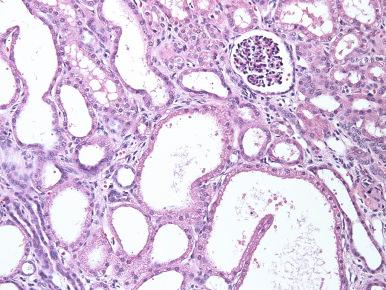
DMS is a rare condition characterized by the early onset of severe proteinuria, characteristic glomerular morphology, and rapid progression to end-stage renal failure before the age of 3 years. DMS can occur in an isolated form or associated with some well-characterized syndromes. Denys–Drash syndrome (DDS), a rare autosomal dominant disorder, is characterized by early onset nephrotic syndrome, male pseudohermaphroditism, and Wilms tumor. Incomplete forms of the syndrome, consisting of glomerulopathy associated with either genital abnormality or Wilms tumor, have also been described. Mutations of the WT1 suppressor gene located on chromosome 11p13 have been demonstrated in nearly all patients with the complete or incomplete forms of the syndrome. Other syndromes described with glomerular pathology of DMS include Galloway–Mowat syndrome ( WDR73 gene mutation), Pierson syndrome ( LAMB2 gene mutation), and a familial steroid resistant nephrotic syndrome (with mutations in PLCE1 gene), all with autosomal recessive modes of inheritance. Young children with Galloway–Mowat syndrome have microcephaly and seizures in addition to steroid-resistant nephrotic syndrome. Ocular abnormalities such as microcoria, neurologic deficits, and congenital nephrotic syndrome characterize Pierson syndrome. The proteins encoded by all these candidate genes have a role in either podocyte differentiation or function of glomerular filtration barrier. A genetic basis for the sporadic cases of DMS is very much plausible but is unclear in most instances. On rare occasions, cytomegalovirus inclusions were identified in newborns with congenital nephrotic syndrome and glomerular changes of DMS.
In patients with DMS, the nephrotic syndrome can develop as early as first week of life, but it is more likely to appear after the third month. In contrast to the Finnish type, the nephrotic syndrome in DMS is not associated with a large placenta, premature birth, or low birth weight. DMS does not recur after transplantation.
By light microscopy, the glomeruli in early DMS show prominent crowded podocytes reminiscent of fetal appearance. Pseudocrescents with proliferating visceral and parietal epithelial cells have been observed. Subsequently, the glomeruli display increased mesangial sclerosis and consolidation ( Fig. 23.28 ). In advanced stages, there is marked TA with IF. The findings by electron microscopy are extensive obliteration of the epithelial foot processes, basement membrane thickening and lamellation, and an increase in the mesangial matrix. By immunofluorescence, deposition of IgM, C3, and C1q is demonstrable in the sclerotic mesangial areas.
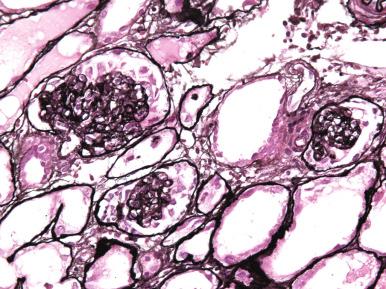
Another major clinical presentation of patients with glomerular lesions is the acute nephritis syndrome. Patients with this syndrome present with hematuria, azotemia, oliguria, and mild to moderate hypertension. Urinalysis reveals an “active” sediment, which consists of the presence of red blood cells, leukocytes, and red blood cell casts. Proteinuria is common but is rarely in the nephrotic range. Edema, when present, is usually mild and is frequently manifested by facial puffiness. Variants of the clinical syndrome include milder forms with microscopic hematuria and non-nephrotic proteinuria, on occasion associated with mild hypertension, and a fulminant form known as rapidly progressive glomerulonephritis. As with the nephrotic syndrome, the histopathologic lesions that can give rise to this clinical presentation are varied.
Diffuse endocapillary (or intracapillary) proliferative glomerulonephritis is a term used to describe lesions characterized by both mesangial and endothelial proliferation. Although this category has become virtually synonymous with acute poststreptococcal glomerulonephritis, it may occur after infections caused by other bacteria including staphylococci, meningococci, pneumococci, Klebsiella , Salmonella , enterococci, Brucella , Leptospira , and mycobacteria. It can also arise as a complication of rickettsial infections; viral diseases including hepatitis B, varicella, mumps, measles, cytomegalic virus, and infectious mononucleosis; and parasitic conditions such as malaria, trichinosis, and toxoplasmosis.
Poststreptococcal glomerulonephritis is primarily a disease of childhood, usually occurring between the ages of 5 and 15 years, but it can affect individuals of any age. Approximately 5% of the patients are younger than 2 years of age. Males are affected more commonly than females, with a ratio of 2 : 1. Significantly higher incidence of poststreptococcal glomerulonephritis is seen in less developed countries when compared to the Western world and may even be underestimated due to subclinical cases. The disease profile in developed countries is often different, more frequently affecting elderly individuals with comorbidities.
In the classic form, the disease occurs within 1–4 weeks after infection with a nephritogenic strain of group A β-hemolytic streptococci. The rheumatogenic strains of group A β-hemolytic streptococci (causing rheumatic fever) differ from the nephrotogenic strains by the surface M proteins. Primary infections may be either pharyngeal or, less commonly, cutaneous. The principal serotypes implicated in glomerulonephritis are streptococci of group M types 12, 4, 1, and 49. The risk for developing glomerulonephritis after infection with a nephritogenic streptococcus is variable, depending on a variety of host and virulence factors, but the overall risk is estimated to be about 15%. The clinical, morphologic, and serologic findings indicate that poststreptococcal glomerulonephritis is an immune complex disease, and the main target antigens implicated thus far include “streptococcal pyrogenic exotoxin B” (SPEB) and “nephritis-associated plasmin receptor.” SPEB is a cationic protein that co-localizes in the subepithelial deposits and both antigens promote plasmin activity, contributing to glomerular tissue injury. In addition, the circulating antigen-antibody complexes deposit in subendothelium, activate the alternative and possibly lectin complement pathway, and trigger an inflammatory response.
Clinically, this disease is manifested by a rather abrupt onset of gross hematuria, edema, proteinuria, hypertension, and impaired renal function. Antibodies to certain streptococcal antigens, such as antistreptolysin O (ASO), are elevated, but this finding may not be helpful in diagnosis due to the ubiquitous nature of streptococcal infections. The serum levels of hemolytic complement activity and C3 protein are abnormally reduced early in course of the disease, but the values return to normal in less than 8 weeks. During the acute episode of poststreptococcal glomerulonephritis, 2%–5% of the patients die as a result of complications such as pulmonary edema, hypertensive encephalopathy, or rapidly progressive renal failure due to crescentic glomerulonephritis; and these figures are much higher in elderly patients. The long-term prognosis of patients with acute poststreptococcal glomerulonephritis is good, especially in children, with only a small number of patients progressing to chronic renal failure many years after the acute episode. Recovery in adults is less predictable than in children, especially with persistent proteinuria or when the initial episode is associated with severe renal impairment and nephrotic syndrome. Progression of renal disease is more common in patients who develop crescentic glomerulonephritis. Since the clinical syndrome of acute poststreptococcal glomerulonephritis may be quite distinctive and the overall prognosis is excellent, biopsies are not commonly performed unless atypical features complicate the presentation, such as nephrotic syndrome, anuria, acute renal failure, persistent or severe hypertension, or lack of recovery after 6 weeks. On long-term follow-up, approximately 17% of the patients have persistent mild proteinuria, microhematuria, or hypertension. Recent studies have indicated an overlap between atypical postinfectious glomerulonephritis and C3 glomerulonephritis (C3GN), as several of these patients with persistent late symptoms have alternative complement pathway abnormalities. In addition, it appears that streptococcal infections may act as a trigger for precipitating C3 glomerulopathy in a genetically predisposed individual.
Light microscopic examination of biopsies taken within a few weeks of onset of disease shows diffuse enlargement of the glomerular tufts that tend to narrow the Bowman space. Glomerular intracapillary cellularity is increased due to mesangial proliferation and, to a lesser extent, proliferating and swollen endothelial cells. This results in narrowing of the capillary lumina and accentuation of the lobular glomerular pattern. Infiltration by leukocytes can contribute to the capillary obstruction as well, and, when prominent, the term exudative glomerulonephritis has been used ( Fig. 23.29 ). Accompanying the polymorphonuclear leukocytes are mononuclear cells and, on occasion, eosinophils. Segmental necrosis and thrombosis with crescent formation are uncommon findings but indicate poor prognosis.
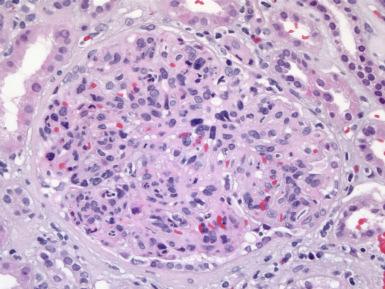
The most characteristic ultrastructural feature in the early stages of the disease is the presence of subepithelial, dome-shaped, electron-dense deposits called humps ( Fig. 23.30 ). The deposits are separated from the lamina densa by a recognizable lamina rara externa, and the foot processes of the podocytes overlying the humps are usually obliterated. In general, there is a correlation between the number of humps and the degree of polymorphonuclear cell infiltration, but the humps may occur in loops devoid of leukocytes. Intramembranous deposits, some of them in continuity with the humps, and small subendothelial and mesangial deposits are not uncommon.
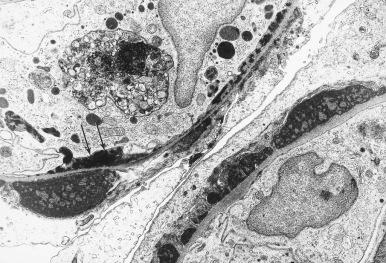
Immunofluorescence studies during the acute phase of the disease typically reveal granular staining for IgG and C3 along the capillary loops where the humps are located ( Fig. 23.31 ). Small amounts of IgM and IgA may be found. Properdin is frequently present and this, coupled with the strong reactivity for C3 and the absence of C1q and C4 in the deposits, suggests involvement of the alternative complement pathway.
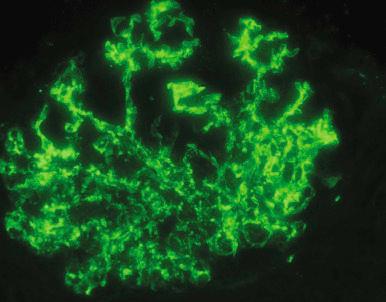
Serial biopsies show a gradual resolution of the glomerular changes. Cellularity decreases and the humps generally disappear in 6–8 weeks, though they can be identified up to 6 months after the onset of the disease. During the resolving phase, the basement membrane may show focal irregularities with decreased electron density, the capillary lumina become patent, and the endothelial swelling and polymorphonuclear leukocytic infiltration disappear. Electron-dense deposits either are no longer visible or are confined to the mesangium. IgG may not be demonstrable, and C3 staining gradually disappears from the periphery and becomes restricted to the mesangial areas. Complete restoration to normal histology occurs as early as 6 months and certainly within 2–3 years. In a small percentage of cases, mesangial hypercellularity, mesangial deposits, and increased mesangial matrix may persist for years after the acute episode, and the mesangial prominence tends to be focal and segmental.
Infection-associated glomerulonephritis in the developed countries is being increasingly caused by Staphylococcus aureus, especially the drug-resistant strains. Unlike poststreptococcal glomerulonephritis, staphylococcal infection-associated glomerulonephritides are more common in the elderly population (over 60 years of age) with comorbidities such as diabetes mellitus, drug abuse, alcoholism, and malignancy. The underlying infection is typically ongoing (rather than “post-infection”) and is often brought to attention by the kidney disease. The characteristic feature of this entity is IgA-dominant or co-dominant immune deposits that are seen in addition to C3. The IgA-dominant host immune responses appear to play a role in this morphologic variant of infection-associated glomerulonephritis. It has been postulated that the S. aureus enterotoxins and possibly other antigens function as “superantigens,” capable of binding directly to the major histocompatibility complex (MHC) class II molecules on antigen presenting cells without the required intracellular antigen processing to form receptor-fitting peptides. In addition, these superantigens bind to T-cell receptors, causing massive T-cell activation, proliferation, and cytokine release. These events in turn trigger polyclonal B-cell activation, and patients with S. aureus infections were shown to have polyclonal elevation of serum IgA and IgG. The most common presentation is acute renal injury, proteinuria often in the nephrotic range, and hematuria. There appears to be a male predominance, and two-thirds of the patients have mild hypocomplementemia. A small percentage of patients may present with lower extremity rash, reminiscent of Henoch–Schönlein purpura (HSP). Reported underlying infections have included osteomyelitis, pneumonia, septic arthritis, empyema, sinusitis, and endocarditis, among others. The latent period between the onset of infection and renal manifestations appears to be 4–5 weeks, but in most cases the infection is not recognized until the time of the kidney biopsy. Treatment of underling infection is the main form of therapy and overall, the prognosis is inferior to poststreptococcal glomerulonephritis, possibly related to the patient's age and associated comorbidities.
The glomerular changes on biopsy can be variable, ranging from mild mesangial hypercellularity to diffuse endocapillary proliferation and on occasion, crescents; exudative features are not uncommon, although seen less frequently than in poststreptococcal glomerulonephritis. There is usually accompanying acute tubular injury and interstitial inflammation, but vasculitis is not a feature observed on kidney biopsy. In patients with diabetes mellitus, subtle changes of glomerular endocapillary proliferation may be masked by prominent Kimmelstiel–Wilson nodules. The electron-dense deposits are primarily in the mesangium and paramesangium, but occasional subendothelial deposits are not uncommon. The subepithelial “humps,” the hallmark of infection-related glomerulonephritis, are seen in less than 50% of patients. When present, these subepithelial deposits are often smaller and less “hump”-like. The glomerular immune deposits are composed predominantly of IgA and C3 with less intense or absent IgG. Light chain κ and λ staining is usually seen, and λ can be more intense than κ. These immunofluorescence findings can lead to a misdiagnosis of IgAN, especially in the absence of obvious infection or if the skin rash is reminiscent of HSP. Distinguishing between these two entities is extremely important as immunosuppression for a presumed IgAN will exacerbate an unrecognized infection. Low serum complement levels and subepithelial humps, if present, indicate infection-associated glomerulonephritis rather than IgAN.
Membranoproliferative glomerulonephritis (MPGN; also known as mesangiocapillary glomerulonephritis ) is a term used to designate a distinctive histopathologic pattern of glomerular injury characterized by a combination of mesangial cell proliferation with lobular accentuation ( Fig. 23.32 ) and capillary wall thickening with double contours and extension of the mesangial cell cytoplasm into the periphery of the loop ( Fig. 23.33 ). Based on the ultrastructural morphology and distribution of the deposits, MPGN was traditionally subdivided into two major types: in the first (type I), the deposits are primarily subendothelial ( Fig. 23.34 ); in the second (type II), the deposits are extremely dense and lie within the basement membrane. However, only a minority of later group (about 25%) exhibit the membranoproliferative pattern, and hence the preferred and currently used term DDD instead of MPGN type II. In addition, other variants referred to as type III, which show either extensive disruptions of the lamina densa or frequent subepithelial deposits, have been described.
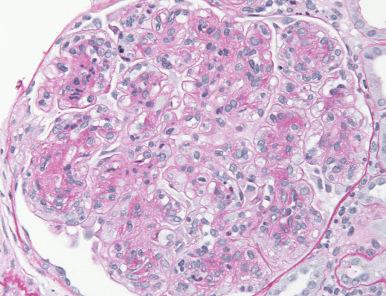
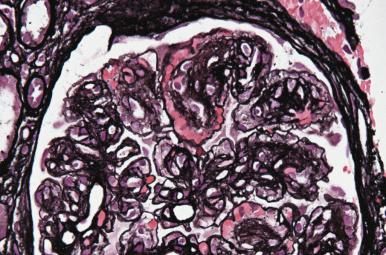
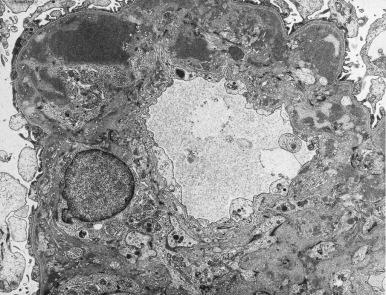
Although the traditional subdivision of MPGN implied various morphologic patterns of a single clinicopathologic entity, the conditions do not share a common pathogenesis and they are linked only by the morphologic similarities on routine light microscopy. Recent studies have helped gain insight into the pathophysiological mechanisms of “MPGN” and related entity of C3GN. Although the classification scheme is evolving, these disorders fall broadly into two categories ( Box 23.4 ). The first, C3 glomerulopathy , consists of glomerular diseases with prominent C3 deposition with little or no immunoglobulin deposition. It encompasses DDD, C3GN, and familial forms of MPGN and is associated with dysregulation of alternative complement pathway. A subset of previously designated MPGN type I and type III belongs to C3 glomerulopathy category under this new classification. The second group, idiopathic MPGN with prominent immune complex deposition (in addition to C3), includes approximately 70% of type I and 60% type III MPGN, as defined by the traditional classification. Several patients in the second group also appear to have alternative complement pathway abnormalities, posing a challenge for an immunofluorescence-based classification system.
(isolated/predominant C3 deposits)
Dense deposit disease (previous term type II MPGN)
C3 glomerulonephritis
Familial C3 glomerulopathy (abnormal CFHR3-1 protein, type III MPGN features)
CFHR5 nephropathy (mutations in CFHR5 gene)
(immune complex deposition; C3 and immunoglobulin deposition)
MPGN type I morphology
MPGN type III morphology
Hepatitis B and C, endocarditis, visceral abscesses, shunt nephritis, malaria, schistosomiasis, mycoplasma, HIV, and Epstein–Barr virus infections
Systemic lupus erythematosus, scleroderma, Sjögren syndrome, rheumatoid arthritis, sarcoidosis, mixed essential cryoglobulinemia with or without hepatitis C infection, ulcerative colitis, sickle cell disease
MGUS, type I cryoglobulinemia, Waldenström macroglobulinemia, fibrillary glomerulonephritis, immunotactoid glomerulopathy
Become a Clinical Tree membership for Full access and enjoy Unlimited articles
If you are a member. Log in here